Würm: Role Playing in the Ice Age by Wapole Languray
Intro
Original SA post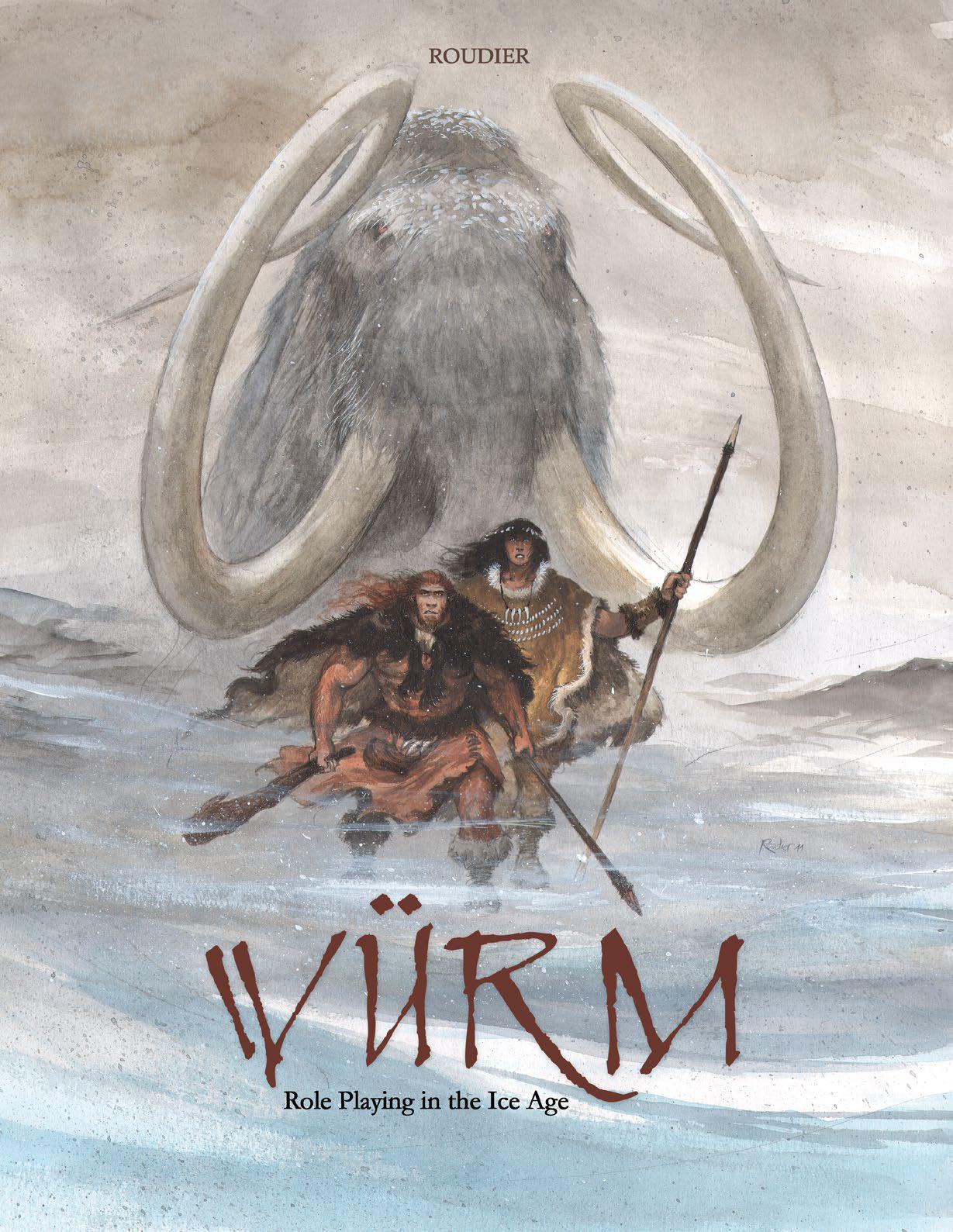
The Ghost Mammoth. WÜRM Rulebook Cover - Watercolour & Acrylic, 2010
Würm is a French roleplaying game originally published by Edition’s Icare, and translated into English by Nocturnal Media, who are the company that currently publishes Pendragon. The translation was funded on Kickstarter back in 2015, allowing a translation of the core book, three supplements, and an art-book. The core book is a compilation of the original French core, as well as several supplements and errata to make one complete book in English, which is what I’m covering.
The primary author and illustrator is French artist and writer Emmanuel Roudier. He isn’t really known in America, but his career is mostly defined by several comics: Vo’Houna, Neandertal, and La Guerre du feu, which essentially act as the source material for Wurm. He’s also done several professional illustrations for exhibits and museums which show up as art for this book.
This book is obviously an enormous passion project for Roudier, who absolutely loves the Paleolithic, and it shows. This book drips quality, and obvious enthusiasm and love for the material. It’s also by far the best game I’ve seen at actually clearly showing what the hell the players are supposed to do, and has some amazing adventure seeds/design/suggestions to help drive campaigns.
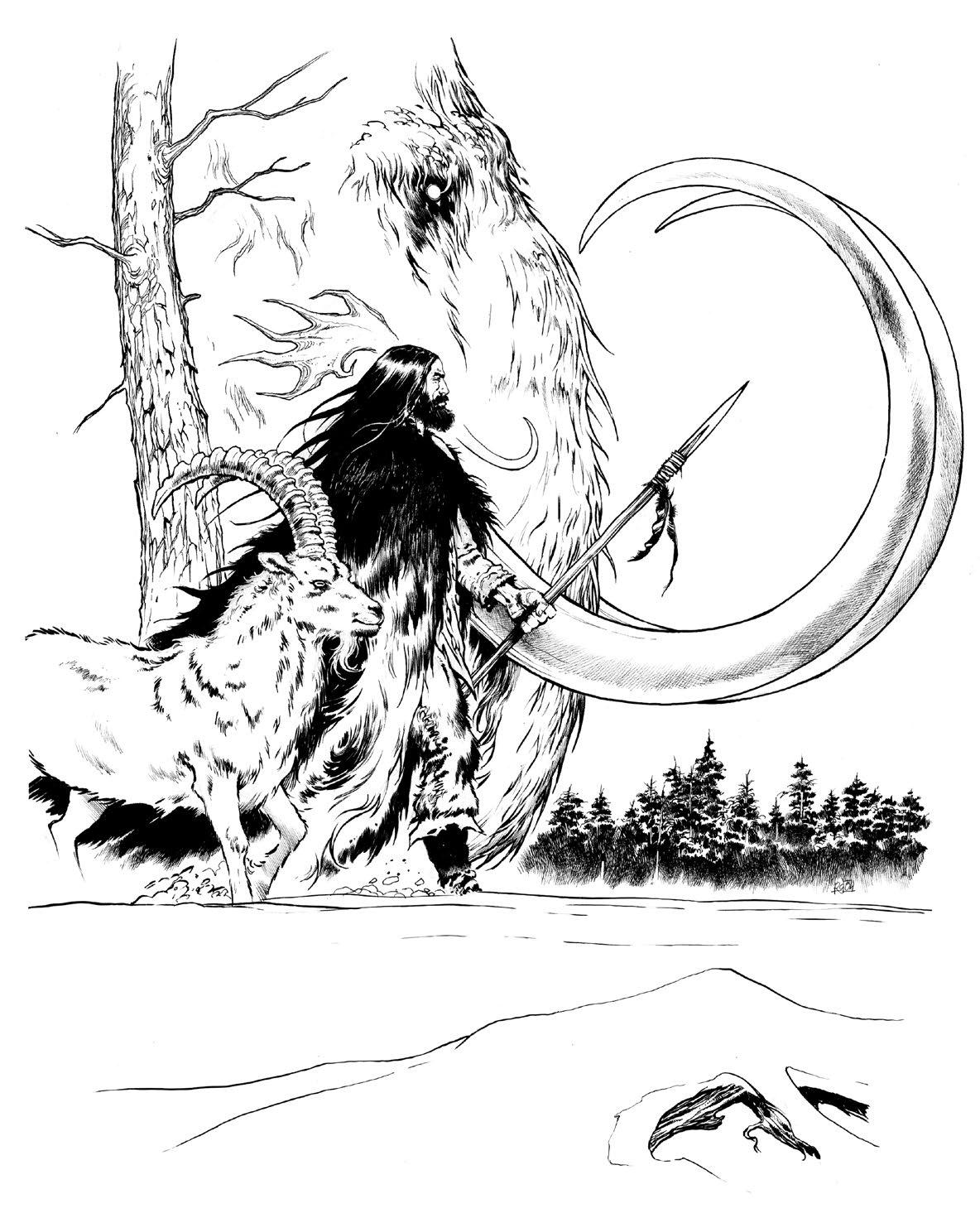
Rearing Horse and his Auxiliary Spirits. Cover Illustration for Vo’huna, Vol.3 - India Ink, 2004
But without further ado, let’s get into it:
Dawé the Damned
The book opens with a bit of introductory fiction, which also turns out to be a stealth adventure seed.
The story is about Dawé Moon-eyes, a Neanderthal woman on her deathbed dying of some mysterious illness while her unnamed son sits b y her bed caring for her. As she lays dying, she tells her son of her life’s story:
When she was young, Dawé caught the eye of Ar-Zul, a hotheaded asshole hunter of her tribe who wanted to make her his woman. Dawé was uninterested in his advances, even to the point that she rejected what was essentially a public proposal from him (A deer hide presented in front of the clan Elders, how romantic!) which turned him hostile and angry toward her.
This apparently didn’t amount to much until the Neanderthals first met with Cro Magnon man. Dawé and her people actually got along wonderfully with the Cro Magnons, exchanging gifts, spending time around each other, and making friends. In particular Black Lion, the hunt leader of the Cro Magnon tribe, and his beautiful sister Shining Magpie, a wonderfully kind girl with an enchanting voice. She was very popular with the Neanderthal boys, particularly Ar-Zul who kept trying to put the moves on her even though Magpie was totally oblivious to his advances.
Well, he apparently got sick of that because one day they find Shining Magpie strangled to death after she was raped! While Ar-Zul was the obvious culprit, the Neanderthal clan elders protected him from consequence blaming the Cro Magnons for bringing bad luck and stirring up hostility with the newcomers.
Black Lion though was actually not a dumbass and sought compromise: As a woman was taken from them, they wanted a woman in return. Not as a sacrifice, but to replace the lost tribe-member. Obviously Dawé was chosen on Ar-Zul’s suggestion because he’s a fucker.
Dawé moved in with the Cro Magnons and actually got along wonderfully, integrating right into her new tribe, eventually falling in love with and marrying Black Lion though she bore him no children. This happy time wasn’t to last though. The Cro Magnons were being devastated by the Curse of Mordagg, a deadly plague that weakens the victim over a month until they die a painful death. Black Lion died, along with many others, before the tribe’s Shaman found a cure for the disease. Sadly Dawé never learned what it was.
The Cro Magnon elders let Dawé free of her bond to them after Black Lion’s death, and she left them to find a new tribe. She eventually settled with another Neanderthal clan led by a chief called Bahor, where she married Ougrar the Brave who is the father of her nameless son. Bahors clan was also plagued by the Curse of Mordagg though. Ougrar died, and Bahor’s tribe sought to escape the disease by leaving the land and going elsewhere, but Dawé stayed in her homeland with her infant son.
Dawé sought new refuge with the clan of her birth, only to find that Ar-Zul was now Ar-Zul the White, the shaman of the tribe, and undisputed decision maker of the tribe. Now, Ar-Zul’s tribe as also getting messed up by the Curse, and he quickly made Dawé the scapegoat for it blaming her leaving the Cro Magnon tribe as the cause of the curse by breaking her word. He exiles her and her child to die out in the wilderness alone.
Thankfully, not everyone listened to Ar-Zul, and some of them secretly helped her out over the years. Now Dawé is dying of the Curse of Moragg as well, and she fears her son will be hounded by Ar-Zul as she was, but she’s got a plan, see!
She tells her son to seek out Black Lion’s tribe, and integrate into them, becoming one of them by using her reputation, in order to learn the cure for the Curse of Moragg. Then, once sonny-boy has the cure, he’s supposed to come back, cure the Curse, and use this influence to throw Ar-Zul out on his wrinkly ass to freeze to death. Then she dies.
Yeah, just make one of the PCs her son, or heck, all the PCs her children, and boom you have a very good start for a campaign about a family of young Neanderthals proving themselves to a tribe of Cro-Magnons in order to take vengeance upon their mother’s persecutor who just happens to be a murdering rapist and powerful shaman.
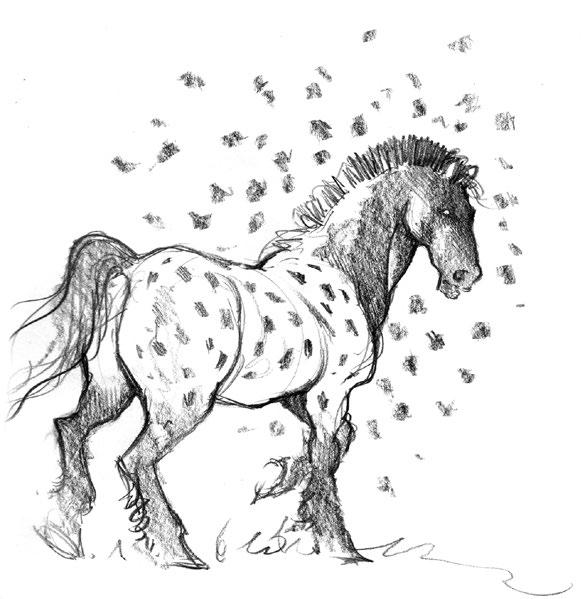
What is Würm?
Well, first an explanation of the name: Würm comes from the Würm Glaciation, which is in turn named after the Würm River in Bavaria. The Würm Glaciation was the most recent period of expansion for the Alpine glaciers, which corresponds with the Weichselian Glaciation to the north.
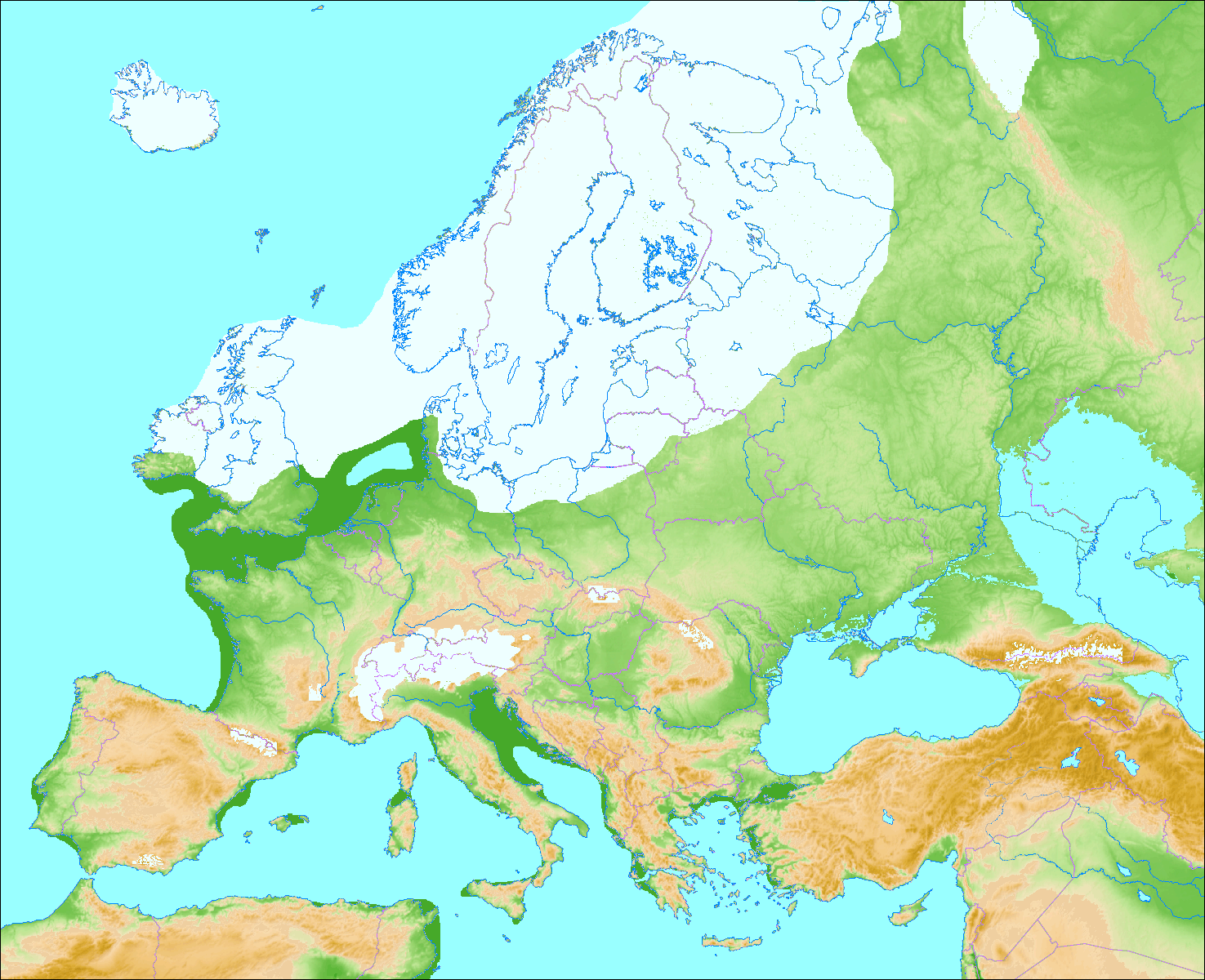
Here’s a map showing what Europe looked like at the time
This Ice Age lasted from 115,000 to 11,700 years ago, though Würm the game is more accurately set approximately 35,000 years ago, which is right in the middle of the meeting of Neanderthal and Cro-Magnon men in Europe during the Pleistocene/Paleolithic era.
Now, most of the first chapter is explaining what an RPG is, nicely it does it in depth over an entire 6 pages. It clearly explains what a GM is and does, what players are and do, provides an example of play based around not rules but explaining exactly how you talk when playing an rpg and what each person is expected to actually physically do duringplay, how rolling die works on a conceptual level, explains common terminology like “session” and “campaign” and basically is what I’d give someone who has no idea what the hell an RPG is.
I believe this is in large part because the game is in part designed to be child-friendly, and there are optional rules for playing as children-characters for kid appropriate adventuring as well, so it’s overall very new player friendly.
So, next time we’ll jump right into Chapter 2: Character Creation!
Extra Art I Couldn’t Fit In Between the Text
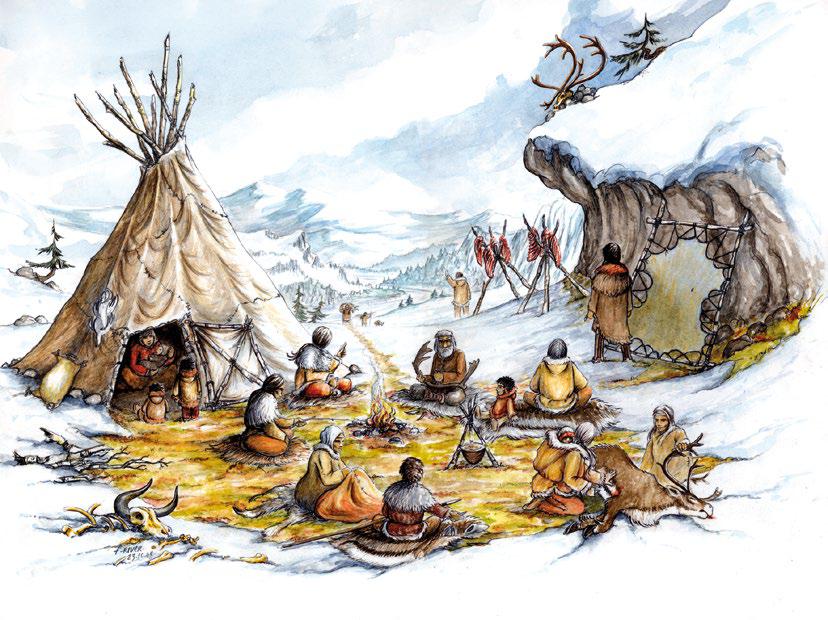
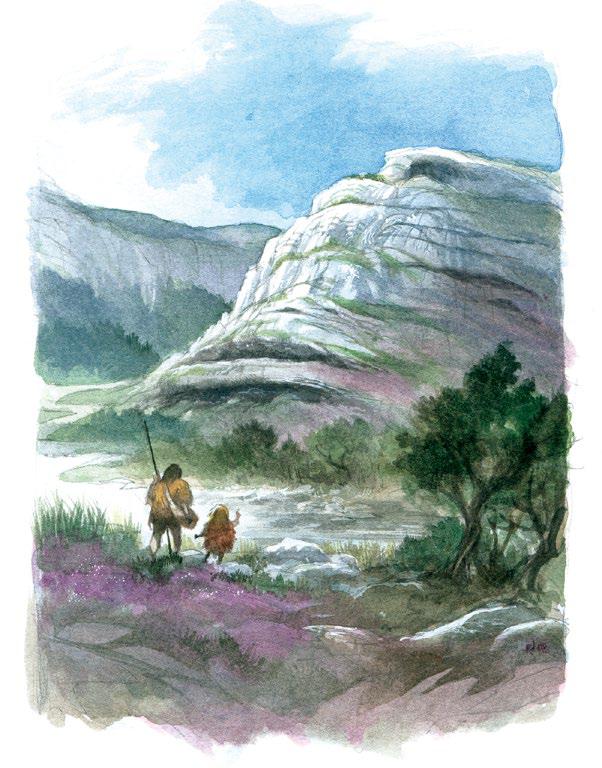
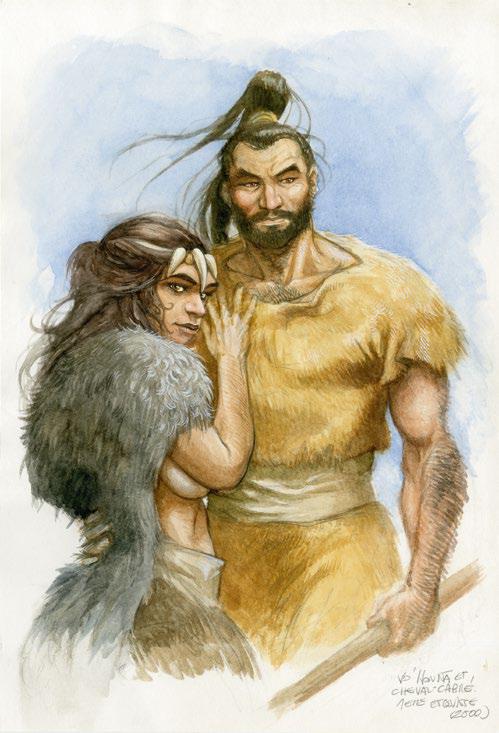
Vo’huna & Rearing Horse. First Sketch - Pencil & Watercolour, 2000
Chapter 2: Creating a Character
Original SA post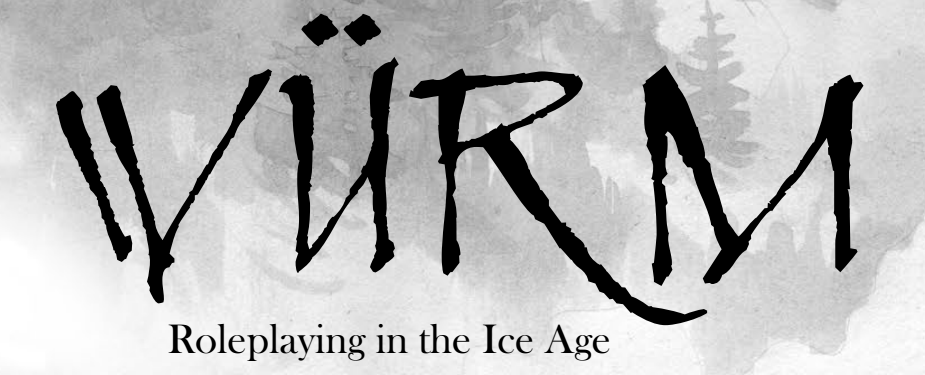
Chapter 2: Creating a Character
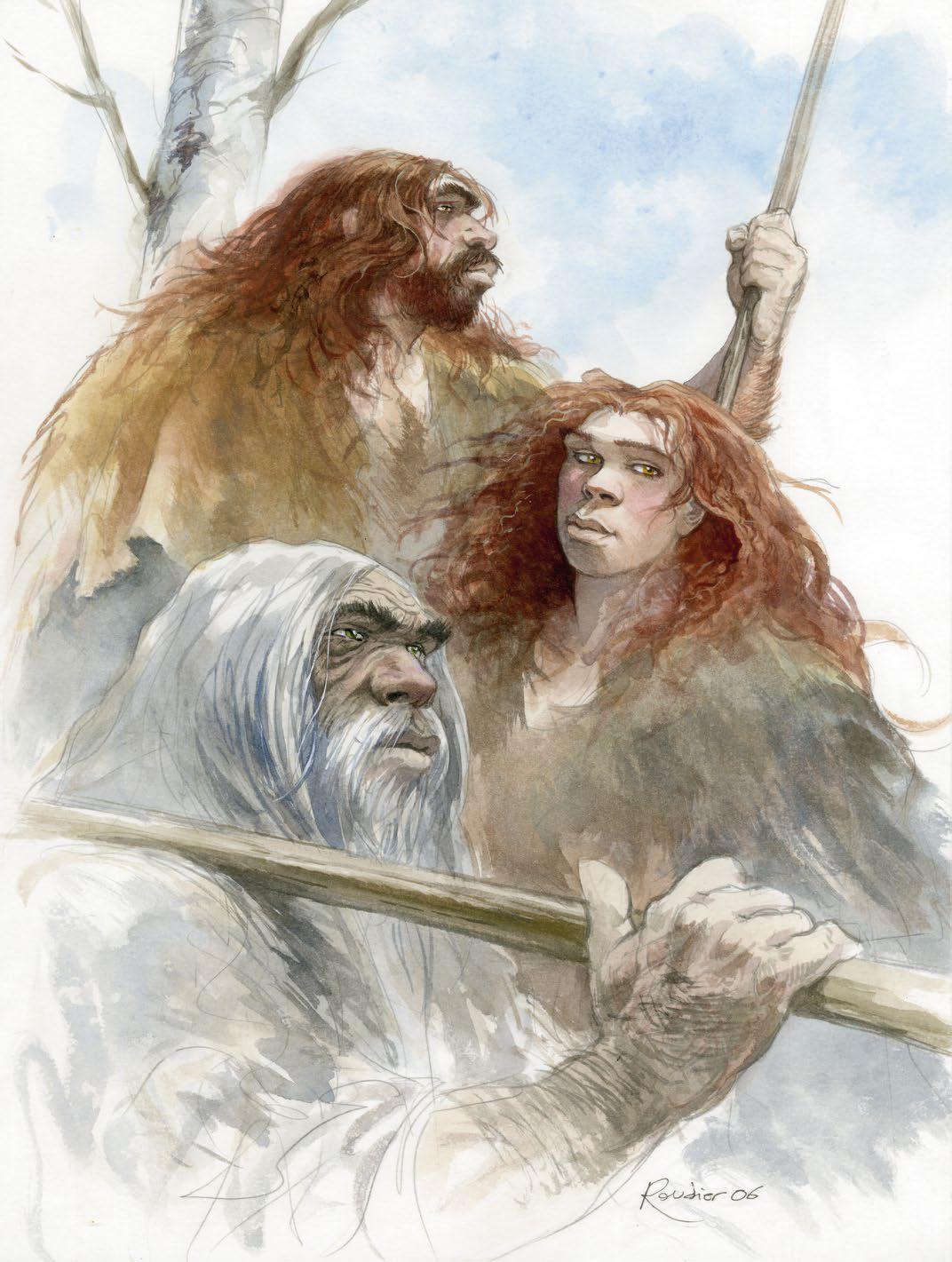
Faudraug, Vo’huna & Gohoum. Illustration for the Neanderthal Museum, Germany - Pencil & Watercolour, 2006
Character creation in Würm is cooperative between the Players and GM. The default assumption is that the GM will, before players make a character, already have decided what species the players are playing, which tribe or tribes they are part of, and what role the players are filling in the campaign. The individuals are of course totally up to the players, but I feel this sort of guided approach can help a lot to prevent incompatible parties and smooth out character creation.
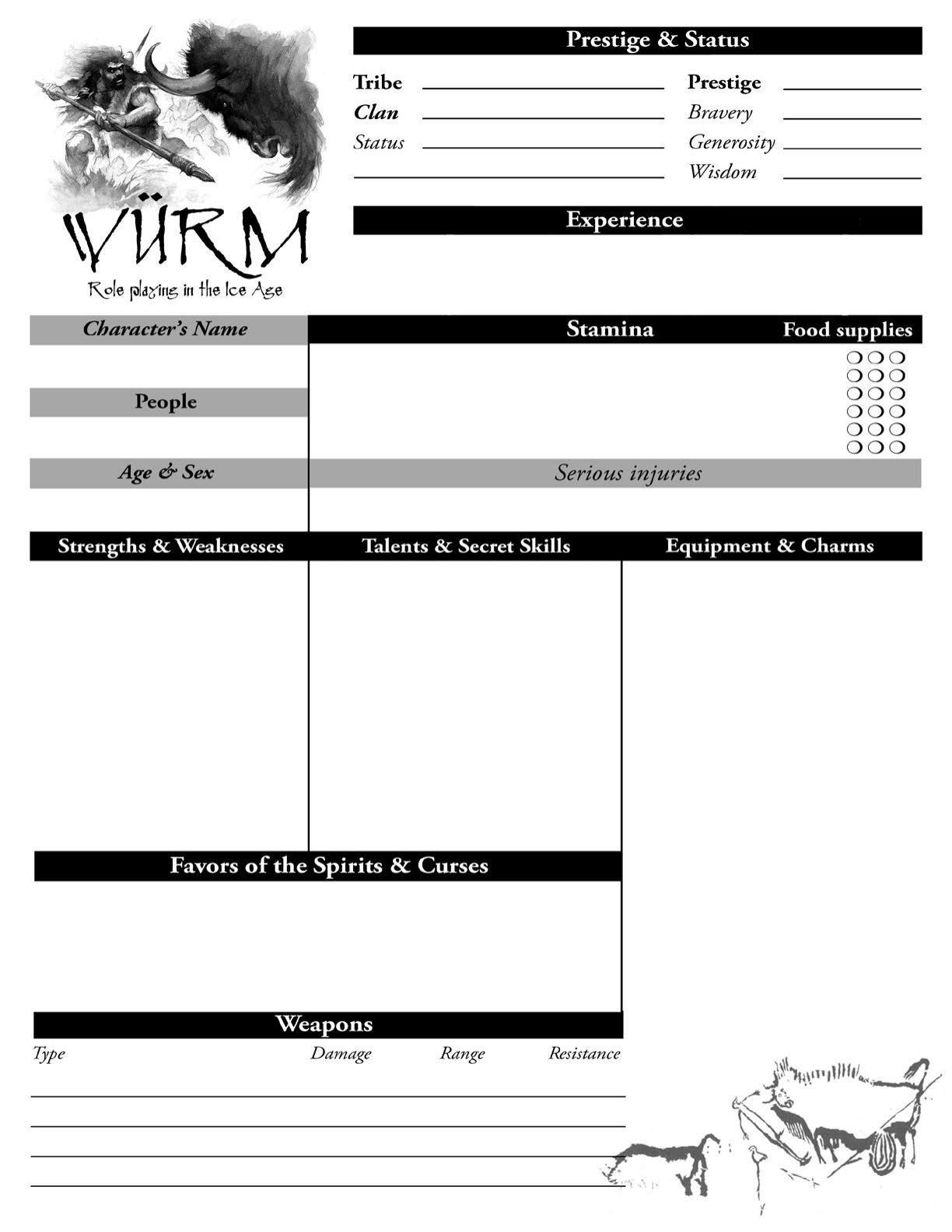
Peoples and Tribes
So, let’s grab the character sheet and start making a character. The first decision, though it may actually be defined by the GM, is the species of the characters. This legit has huge effects mechanically, affecting almost every part of the game. As this is Pleistocene Europe, there are two species to choose from:
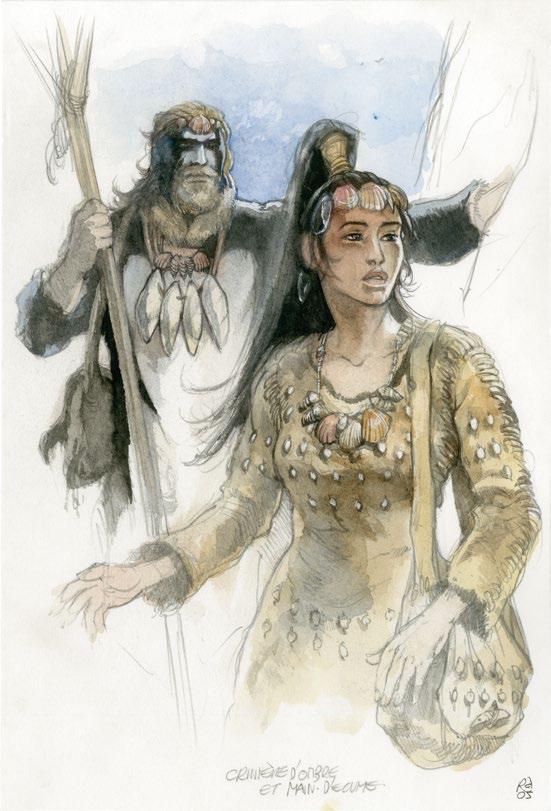
Foam Hand & Shadow Mane. Characters sketch for Vo’huna - Pencil & Watercolour, 2005
Long Men Homo sapiens sapiens
Long Men are us, modern humans. In popular terms these are Cro Magnon, from the French Abri de Cro-Magnon, meaning Rock Shelter of Magnon’s, the shallow cave where the first Cro Magnon remains were discovered. Anatomically the Long Men are nearly identical to us, with a trend for heavier bodies, slight brow ridges, and a slightly larger brain cavity. Most Long Men have darker complexions, ranging from tanned to dark brown, fitting as humans migrated into Europe through the Middle East and therefore likely did have a Middle Eastern or Mediterranean look. They have black hair, with brown, black, or blue eyes.
Long Men live in large clans of 20 to 40 individuals which are semi-nomadic and live in large comfortable huts. The Long Men of Würm are part of the Aurignacian culture, with some clans having elements of early Gravettian culture present. This will be better explained in later chapters when we get to crafting and the culture of the peoples of the Ice Age, but it means they’re the more “advanced” culture at the time.
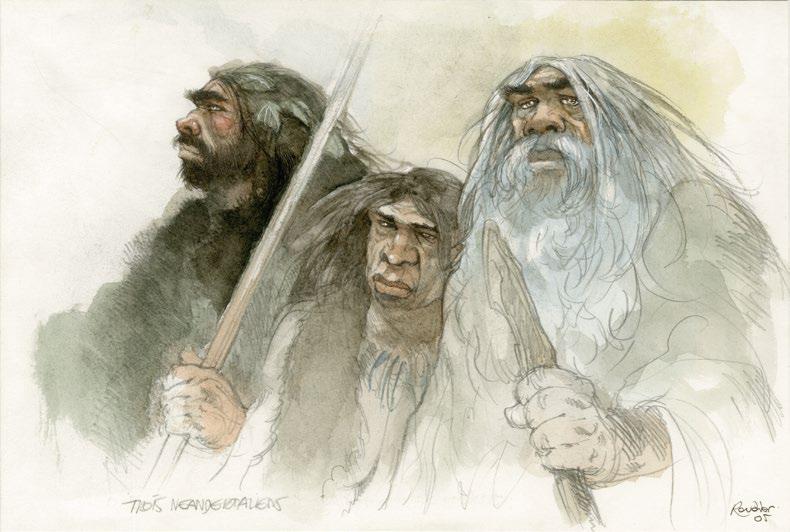
Trolv, Mehoun’tha & Gohoum. Characters sketch for Vo’huna - Pencil & Watercolour, 2005
Bear Men Homo sapiens neanderthalensis
Bear Men are what we call Neanderthals, a human subspecies seemingly native to Eurasia that evolved simultaneously alongside Homo sapiens sapiens. Bear Men are sometimes called Trolls by Long Men. Bear Men get much more description than Long Men as one would expect, so “bear” with me!
Bear Men were shorter than Long Men as a rule, with Long Men males standing around 6 foot tall and Bear Men averaging 5 foot, smaller than even the average Long Men female. Heights among Bear Men don’t vary by sex though, as both males and females have the same average stature.
Bear Men have very distinctive faces, with large jaws, small or no chin, a long wide nose, and a large prominent brow ridge above the eyes. They have fair to pale skin, with lighter brown, blonde, or even red hair and amber, green, or hazel eyes.
While smaller, they are much more powerfully built than Long Men, with much thicker bones, heavier ligaments and much more powerful muscles. This also is the same between sexes, with Bear Men women being just as physically imposing as the males.
Hairless or Hairy? The Neanderthal Look
Basically, no one knows what Neanderthal’s looked like. We have skeletons, so we can get their general shape, height, etc down, and also reasonably infer things like muscle size/power, facial features, and locomotion, but most of the rest is unknown. How pale or dark was their skin? Eye color? Were their noses bulbous, or upturned, or maybe both? We know they had hair, but how much? Was it like modern humans? More body hair? A full on ape-like covering of fur? Were their ears big or small? Round or pointed? Flat back or sticking out?
By default Würm assumes a human-like Neanderthal appearance, as seen in the illustration at the beginning of this post, but acknowledges GMs can do whatever they like and it won’t mess with the rules or ruin the setting in any way.
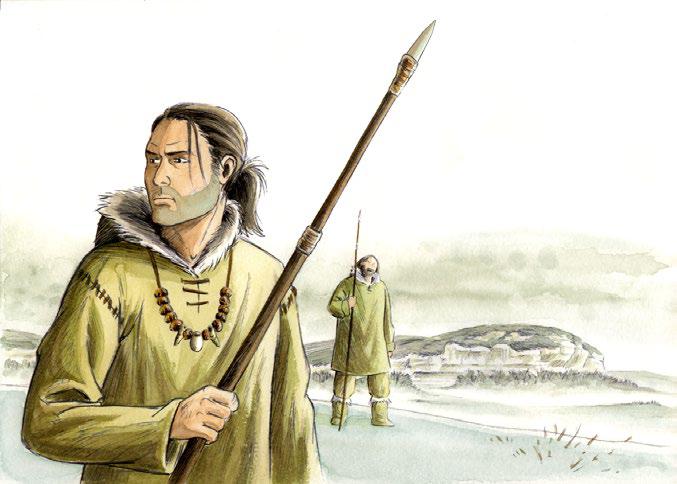
The Tribe
As mentioned before, the Tribe and Clan of the players are most likely going to be defined ahead of time by the GM based on their own ideas or on the adventure/campaign being played. But as normal, players and GMs can collaborate to make one up, or even play as members of several different Clans or Tribes. This section also goes into what a Tribe or Clan is:
Basically a Clan is a group of one or more families that are all connected by a common lineage or ancestry. This forms the most basic social unit of the Paleolithic world, and they generally stick together.
A Tribe is made up of several clans who share a common authority or system of government, essentially being a grouping of related or friendly clans.
Gender and Age
Gender is actually covered in a later chapter, about the roles of Women and sex in the Ice Age, but this bit basically says it doesn’t matter for the rules. Mechanically Men and Women are identical in Würm.
Age is different though: Bear Men reach maturity three or four years earlier than Long Men do. So Long Men are considered adults at around 15, while Bear Men are adults at 12. For women the “coming of age” is based on their first menstrual cycle, but it roughly matches with men age-wise. As a rule of thumb, over 25 would be considered mature, and over 50 is thought of as being properly old, though obviously people live for much longer than that if they’re lucky and well cared for.
You can of course choose age, but if players want to randomly generate theirs, the game suggests rolling 1d6 and adding 14 for Long Men and 10 for Bear Men to get a starting age for their character.
Choosing to Play Long Men or Bear-Men? How to Start?
In short: Long Men are more familiar to players as they are psychologically and physically similar to modern humans, and people have a lot of stone-age hunter gatherer societies like the Native Americans, Inuit, Aboriginal Australians, etc to draw inspiration from. Bear Men are more alien both physically, and possibly mentally if the GM wants to run it that way, but players may enjoy the additional challenge or novelty of playing a non-human.
THis section also advises to avoid caricature and parody: the Ooga Booga cartoon caveman with the leopard skin toga and rough tree branch has no basis in reality and kills the mood of the game. There are other RPGs suitable for playing a comedic prehistory style of game (Og: Unearthed Edition is real good, especially if you’re a little drunk) but Würm is not it.
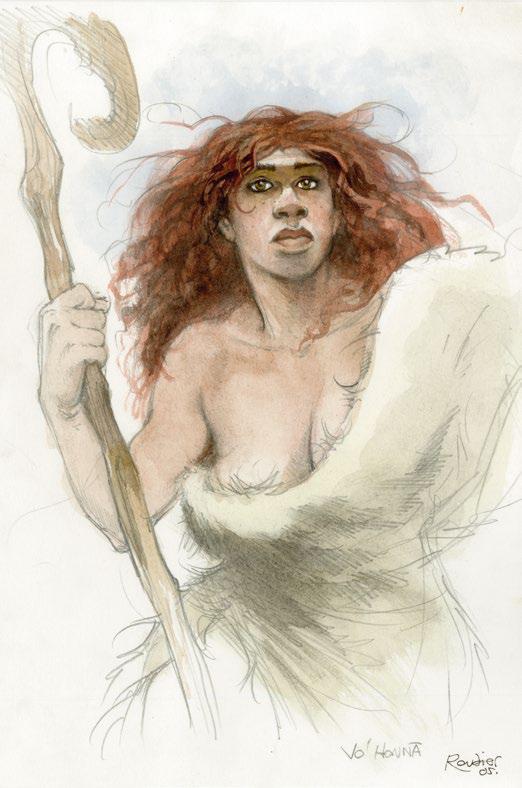
Vo’huna. Character sketch for Vo’huna - Pencil & Watercolour, 2005
Strengths
Strengths are one of the main ways to differentiate different characters. These are situational bonuses that allow players to specialize their characters and have areas of expertise. Generally this bonus in the form of a 1d6 bonus to a specific action or set of actions, though other benefits are possible.
Each character starts with 3 Strengths: One determined by whether the character is a Long Man or Bear Man and two others of the players choice. Players can start with 4 Strengths, but then they also have to take a Weakness (covered after the Strength chapter).
Now, Strengths are each tied to an Animal or natural feature, representing the characters bond to a Totem Spirit of that beast. This is actually a balancing feature: if a character ever kills one of the animals associated with a Strength not in self-defense, or eats the flesh of the creature outside of a ritual context, he loses that Strength. One big flaw is that the game nowhere tells you explicitly how to get those strengths back, but it isn’t very hard to infer that the intended course is to seek out a Shaman and have him negotiate with the spirit to restore the strength, possibly in exchange for a quest or service of some sort. There are rules specifically for doing that, so this seems more like a missing reference than a lack of support.
These Totem spirits also act as Auxiliary Spirits if your character is or becomes a Shaman.
List of Strengths
First off I’ll cover the strengths based upon your people. It’s important to note that these are not exclusive: Bear Men can choose a Long Men Strength and vice versa as one of their Strengths of Choice, it’s just that a Bear Man must have one of their two People based Strengths at the start of the game.
Long Men
- Hand of the Ancestors: This represents a bond or connection with the spirit of an Ancestor. This Strength gives a onus for all crafts practiced by the character’s birth tribe. This is useful because crafting is a major part of the game, most of your gear and equipment is going to be handmade, and if you can’t make what you want you can make something to barter for what you want.
- Speed of the Horse: Bonus to Running and Fatigue (from running) Tests. They can run faster and for longer without tiring. This sounds kinda lame, but horses haven’t been domesticated yet. There are no mounts, and the only vehicles available are water-craft. If you want to move over land you’re hoofing it.
Bear Men
- Strength of the Bear: You are BUFF. Bonus to all Strength Tests relating to raw physical power such as pushing, pulling, lifting, etc, and a bonus to all Damage inflicted in combat. Obvious utility this.
- Heart of Ice You get a bonus to any Test involving resisting the effects of cold or pain, including from Serious Wounds taken in combat. Environmental threats are a legit part of the game, not just a rare thing if the GM remembers the rules exist like in other games.
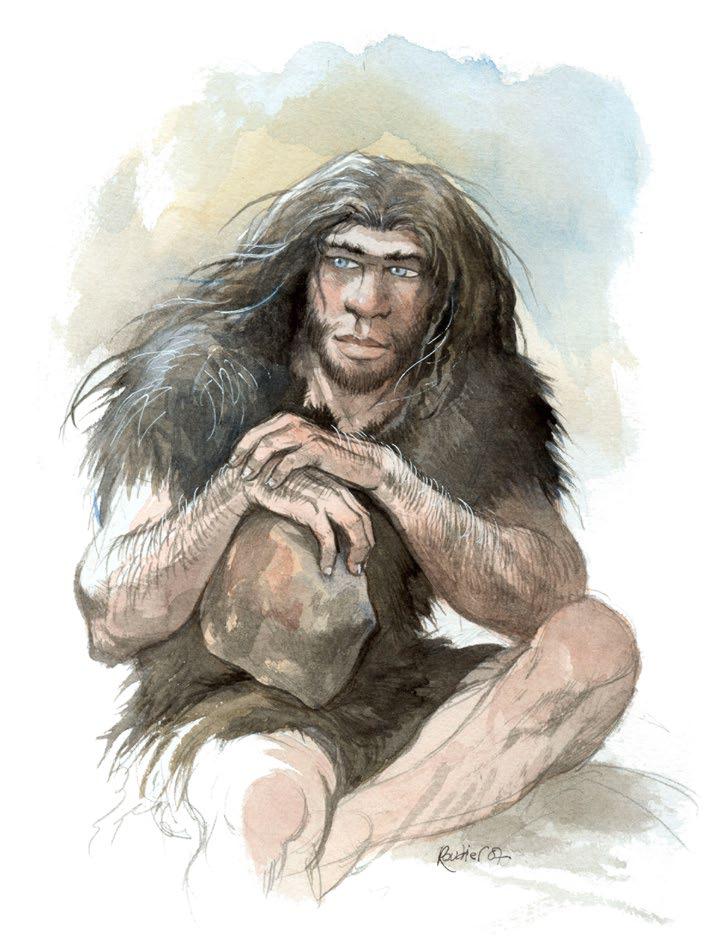
Laghu. Character sketch for Neanderthal - Pencil & Watercolour, 2007
Now that that’s done, let’s go over the rest of them!
- Majesty of the Aurochs: This is the leader-type charisma Strength. You get a bonus for any social activity where raw charisma could help.
- Secret of the Bear: Be a super spelunker! Characters with this Strength get the bonus to moving and orientation Tests when underground, and you’re never afraid of caves and the underground.
- Knowledge of the Beaver: Be a Caveman General Contractor! A bonus to building shelters, huts, traps, and floating transportation.
- Might of the Bison: Strength and Fertility. Bonus for any tests involving physical Strength, to damage inflicted in combat, and applies to rolls for impregnation and giving birth.
- Song of the Blackbird: This represents having a beautiful voice, and gives a bonus to any tests using your voice, such as bartering, singing, lying, etc.
- Flight of the Crow: Bonus to Ranged Attack test, but not to damage. Applicable to any ranged attack at all, not just specifically ranged weapons, so hucking rocks would count as much as a sling would.
- Rise of the Eagle: This is a more complex one, and is only useful if your character is going to be a Shaman. Rise of the Eagle gives a bonus to Trance tests, a prerequisite ability for a lot of Shaman things.
- Breath of the Giant Stag: Makes you haler and heartier. You get a bonus to resisting illness and poison, and an extra 10 Stamina if a Bear Man, and an extra 12 if a Long Man.
- Agility of the Ibex Get a bonus to run, jump, climb, do flippy tricks, etc. Also to help cushion falls and drops.
- Fury of the Lion This strength’s bonus applies to Hand to Hand Attack Tests, similar to Flight of the Crow, but also gives a bonus to frightening or intimidating animals by literally roaring at them.
- Reflexes of the Lynx: This gives bonuses to Initiative Tests, and flat +3 bonus to a character’s Dodge score.
- Softness of the Otter: This one is a bit odd? This lets you be an Ice Age Psychotherapist essentially. The bonus applies to calming emotions and for providing first aid. In addition, if you spend at least an hour each evening delousing, massaging, and comforting another character they get a bonus 1d6 stamina points back during the night, as though they had rested for the entire day before.
- Sight of the Owl: You get the bonuses to any Perception tests involving hearing or sight, and can see at night as well as by day, hear very faint noises, and see farther than others.
- Wisdom of the Mammoth Makes you super-smart. Gives a bonus to any Tests involving knowledge, common sense, and to detect lies or read and understand the emotions of both people and animals.
- Eye of the Panther[/i]This is another Shaman based skill, giving a bonus to Contact With The Spirits tests, an ability shamans have that they use to negotiate with… spirits.
- Magic of the Rhinoceros: This is a neat one: you get a bonus to detect the Enchantments on objects, to creating said enchanted objects and other magical charms, and to resist magical Curses directed at you.
- Inspiration of the Rocks: A bonus to any artistic endeavor, painting, sculpting, engraving, etc. Includes body painting.
- Flame of the Salamander: Yes, this is based on the old myth that salamanders are born from flames, or can survive in flames, or are fire-spirits or similar. The basis is that when people would throw logs taken from the forest floor onto fires, any salamanders hibernating inside would crawl out, “appearing” from the flame. This gives a bonus to Firelighting tests, and any damage caused by fire is divided by 2, rounded up.
- Fins of the SalmonBe the best swim-man! Also a super-fisherman! Presumably you would just throw back any Salmon you caught to not piss off the spirits. Bonus to Swimming and Fishing if that wasn’t clear.
- Grace of the SwanYou get a bonus to Seduction, Charm, and Dance Tests, because you’re hot and graceful. Also may be applicable to animals.
- Venom of the Viper This is an interesting one. You’re better at Sorcery, which is creating potions, ointments, and poisons. Also a bonus to using cataplasm, mundane medicinal herbs and such. You also start with materials to practice these arts.
- Protection of the Vixen: This Strength is of most use to women, but men can find it useful too though to a lesser degree. First, it gives a 1d6 bonus to procreation rolls regardless of sex. Second, if a woman has this, when giving birth she only takes 4d6 damage (normally 6d6), and can roll twice on the Births table and pick the result she wants. It also gives a bonus to resist illness.
- Cunning of the WeaselYour stealth buff! Bonuses to hiding, moving silently, and camouflageing, as well as shadowing people and animals, and getting close to animals without being detected.
- Nose of the Wolf You get bonuses to any tests involving your sense of smell, finding and following tracks, and for finding your way and not getting lost.
And that’s all the Strengths! The rest of this section is just advice for combining strengths that may stack. By default it suggests just not allowing them to be cumulative, and only giving the player the 1d6 bonus even if they have multiple strengths that apply to a situation, but there are rules and suggestions for combining them anyway.
First, you should only allow a 2d6 bonus on rolls that are either really difficult, or super important to the campaign, which probably are also super difficult. It’s a thing that allows the character to overcome a seemingly impossible challenge, not something to let them crush everything they come across.
Breath of the Stag and Protection of the Vixen can be freely combined though, for the 2d6 to resist illness not being something that would upset balance or remove challenge.
The two biggest problem skills are Might of the Bison and Strength of the Bear, as they both buff combat massively. Instead the game suggests a character with these two Strengths get a flat +3 to the relevant rolls in addition to the 1d6 bonus. So, more powerful, but not as insane as a 2d6 bonus. Might of the bison also has a big limiting factor, in that Bison are one of the most common prey animals and so it would greatly limit the characters diet and hunting choices.
Weaknesses
Characters can start the game with up to 2 weaknesses. One if they take an extra Strength at creation, and one if the decide to master a Talent or Secret Skill at creation. These are other special abilities, but they’ll be covered later. You can learn them after creation, this is just if you want to start with one.
As a general rule, a Weakness will inflict a flat -3 penalty to certain rolls, though as with Strengths some have different effects as well.
List of Weaknesses
- Clumsy: Your hands are literally hams and you suck at anything involving manual dexterity. This doesn’t mean tripping over your own feet, but more fine stuff is a struggle. The penalty applies to Craftsmanship, First Aid, and Potion and Cataplasm preparation tests.
- Disfigured: Whether from injury or birth defect, you are not a pretty person. Penalty to any social interaction involving trust or seduction, especially with strangers.
- Fearful: You’re a low-down yellow bellied coward, and a wimp to boot. Penalty to all Hand to Hand Attack and Pain Resistance tests.
- Fragile: Sickly, weak, and prone to illness and injury. You get a penalty to resisting Sickness and Poison tests, and you have less Stamina: -10 for Bear Men and -12 for Long Men, essentially the opposite of Breath of the Giant Stag.
- Half Deaf: Penalty to any test involving hearing, as well as to detecting ambush or surprise attacks. This penalty also applies to any discussion based social interaction because asking someone to repeat themselves constantly and talking unusually loud makes you less persuasive.
- Impressionable: Not gullability, but superstition, fear of the unknown and supernatural. The penalty is applied to any Steady Nerves tests related to the dark, to death, or to magic or the supernatural. This also applies to situations where the character only thinks something supernatural is happening.
- Individualistic: Randian Ubermensch are not a good thing to be in the Stone Age. Your tribemates see you as unreliable and selfish because you’re a libertarian douche and won’t contribute. Any tests where you’re trying to gain the trust of a member of your community are at a penalty, and the communities Guardian Spirit hates you. There’s a 50% chance (1-3 on a 1d6) that whenever the character tries to use or replenish Manna (Essentially this game’s version of Fate Points/Bennies) it will have no effect.
- LameYou’re crippled in some way relating to mobility, either due to injury or birth. Penalties to Running and Agility tests, though tests for Climbing are not penalized.
- One-eyed: Similar to Half Deaf, a One-eyed character gets a penatly to any tests involving vision, and Surprise tests as well. You also get a penalty for all ranged attack tests because you don’t have depth perception anymore.
- Presumptuous Proud, arrogant, stuck up, etc. Your suck at diplomacy because you’re an egomaniac, and get a penalty to Wisdom and Knowledge tests to boot because no never bothered to really learn anything and just go by what you think is right.
- Quick-tempered Diplomacy penalty, and if you feel you’ve been provoked or insulted you have to pass a DT7 (Roll above a 7 on 2d6) to not flip out and start a fight.
- Simple-minded This doesn’t just mean dumb, but also forgetful or scatter-brained. Penalties to Knowledge and Intelligence tests as expected, and to social interactions based upon being charismatic or authoritative.
- Timid: You’re shy and introverted, talking penatlies to any social interaction where you have to talk to someone else.
- Weak: 90lb Cave-Weakling. Penalties to all Strength tests and when determining damage, but this doesn’t restrict what the character can try to do or what weapons they can wield.
And that wraps up Weaknesses! And this post! It’s getting a bit long, so we’ll wrap up Chapter 2 next time with Experience, Stamina, Talents and Secret Skills, Prestige, Equipment, and Playing Children!
Experience
Original SA post
Experience
Right, pay attention you bunch of Homo erectus rejects because this is IMPORTANT!
See, Würm doesn’t use Experience like other games. This isn’t Experience Points you gather to use to become more powerful by buying stuff or hitting arbitrary power-up points. Instead, Experience in Würm is used as a renewable resource to make you better at basically anything.
How it works is this: All characters start with 3 Experience. This increases as characters accomplish feats and complete adventures at values of 1, 2, or 3 based on the length of the adventure and its relative difficulty. These literally represent your character’s increasing life experience and sharpening skills.
Players can spend this Experience to add 1d6 to any roll, except for Talents or Skills the player does not have. This does stack with Strengths and any other bonuses to boot. You can also use Experience to boost Dodge or Running scores by 3 for one Round.
The important thing is: Experience isn’t gone forever. It’s a pool. At the end of the session or adventure, then your Experience Points reset to their maximum value, free for you to spend next time all over again. I really like this system, as it can be used to make characters overall better and more capable over time while jettisoning 90% of the problems traditional EXP systems create like power-creep and crippling overspecialization.
Stamina
Stamina is your HP. It’s an explicit abstract, representing the capacity to withstand not only physical damage and wounds, but also illness, starvation, dehydration, and extremes of heat and cold.
Bear Man characters start with 30 Stamina, and Long Men start with 24. The Breath of the Giant Stag Strength makes that 40 and 36 respectively, and the Fragile Weakness makes it 20 and 16. If you have both they cancel out to be back to default.
When you hit 0 stamina, you’re unconscious, or at least so weak you’re totally out of action and can’t do anything useful or constructive. At -10 you die. This is obviously stolen from D&D, but gives players a nice buffer that means one-hit kills are very rare unless they’re way out of their depth, or someone deliberately finishes off a downed enemy.
Increasing Stamina Points
You can increase Stamina by permanently spending Experience. But, to keep you from dumping it all into Stamina to become superfat you can only spend one point per session, and had to have earned Experience during that session.
The stamina gains are not 1:1 though. Each Experience Point spent on Stamina gives you greater benefits. Starting with +3 Stamina at 1 XP spent, up to +20 Stamina for the 8 XP spent. Once you spent 8, you can not increase Stamina anymore, so there is no infinite HP inflation to worry about.
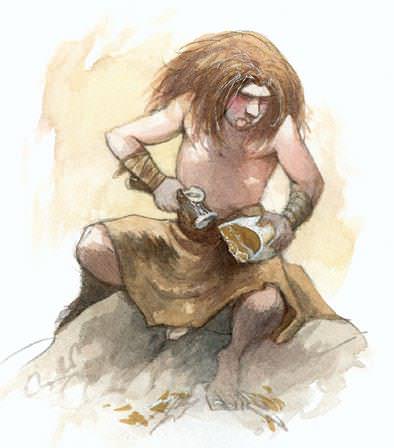
Talents and Secret Skills
These are covered in depth in Chapter 5, but this is basically an introduction to how they work for character creation purposes. Talents are based on Craftsmanship and Art, while Secret Skills are split into Combat, Shamanism, Enchantment, and Sorcery.
All characters start with all the basic Talents known by their tribe or clan, based upon that clan’s culture: Mousterian, Châtelperronian, Aurignacian, or Gravettian. In addition they can take one additional Talent or Secret Skill to start with if they also start with an additional Weakness.
Any additional Talents or Secret Skills must be earned in-game. The game does advise increasing the starting Experience and allowing to start with additional Talents or Secret Skills if you play a one-shot or short series of adventures instead of a long running campaign, and for any replacement characters in case of mid-campaign death.
Prestige
Social standing is actually given a lot of focus in Würm, and act as a sort of secondary experience system. Prestige is an important way of determining social standing in a world where hierarchical societies are basically nonexistent. Prestige is a combination of three sub ratings: Bravery, Generosity, and Wisdom.
Bravery
Characters gain Bravery points by facing danger and performing dangerous tasks. It’s earned by hunting and combat. Points are only earned if you win the fight or successfully complete the hunt. The two determining factors of how many Bravery Points a fight gets is how much damage the most powerful attack your opponent could do, and whether you killed/captured them or they ran away.
If an opponent is captured or killed, you take the maximum value of its highest damage attack (A 4d6 attack would be 24 for example) then divide that by the number of people who participated in the fight or hunt, rounding down to a minimum of 1. This is how many Bravery Points each participant gets. You add 20 points to the Maximum Damage value if the opponent is also a shaman.
Example posted:
For example: killing a mammoth brings in 36 Bravery Points (for its Trampling Attack at 6d6), to be shared between the hunters. If there are five hunters, they all gain 7 Bravery Points (36 divided by 5 = 7.2, rounded down = 7). If there are only two of them, they each gain 18 points (and for taking down a mammoth between them, they deserve it!).
If the enemy runs away or escapes from the fight, you can still earn Bravery, as long as there is someone else to witness the fight, such as another Player or an NPC. For this calculation, you roll the opponent’s strongest attack instead of just taking the maximum value, then divide and round as above but for a minimum of 0. Shamans get a bonus of 10 in this case.
There are also two special exceptions for earning bravery: First, if you manage to win a fight either while suffering a Serious Wound or by finishing with a Critical coup de grace the individual gets a 1 Bravery Point bonus. Second, if you manage to win without anyone else around to see it, you only get 1 Bravery Point unless you bring back a trophy showing proof of your victory.
Generosity
This measures a character's social cache in their society. Paleolithic cultures didn’t have jobs, or what we would recognize as wealth, so instead what people are valued for is their unique contributions to their group. Generosity goes up when you give people gifts or when you perform favors for them
Gifts are simple: Whenever you give someone something then you get Generosity points equal to its Trading Value (Covered later, but essentially how much a thing's worth in barter). There is a limit though, the gift has to be something shaped by the person giving it and intended for a specific individual. Raw materials are generally owned in common by the entire group, and so you have to turn it into something to be considered a proper gift. Gifts of raw materials can work when given to other groups besides your own, but it has to be a lot of stuff.
Favors gain points based upon difficulty or importance of the task, and is up to the GM to determine.
One thing to note is that Generosity does not represent kindness, but instead how much your character can effectively contribute to the wellbeing of others in their society. People with high Generosity are not necessarily nice or kind but instead are seen as being powerful, loyal, and a useful member of their society.
Wisdom
While presented as an optional rule, Wisdom fits so well into the whole system I don’t see why you wouldn’t include it. Wisdom as it sounds represents your gathered wisdom from living, and how the community sees the quality of your counsel and ideas.
Wisdom is earned by three ways. The first is the simplest: Once your character reaches 20 years old, they gain 1 point of Wisdom every season (2 per year). The second is by showing great wisdom, or carrying out act that would gain you a reputation as being wise or seen as wise, the point value determined by the GM. The third is actually a meta-mechanic where if a player recaps the events of the previous session to the group they get 1 Wisdom point.
The Rest of the Rules
Let’s wrap up Prestige, this is getting long. Everyone starts with 6d6 Prestige, which you split however you like between Generosity, Bravery, and if used, Wisdom.
You can lose prestige, on a case by case basis determined by the GM for acting cowardly, selfish, stupid, etc. Basically you lose prestige whenever you act poorly and shamefully in front of the clan or tribe.
The GM should also play characters with high Prestige as being of more interest to the Spirits of the world, who will pay more attention to them and take a more active role in their lives.
One direct function of Prestige is to determine your Prerogatives. Essentially, as your total Prestige goes up, your character is afforded more privileges and rights within their tribe.
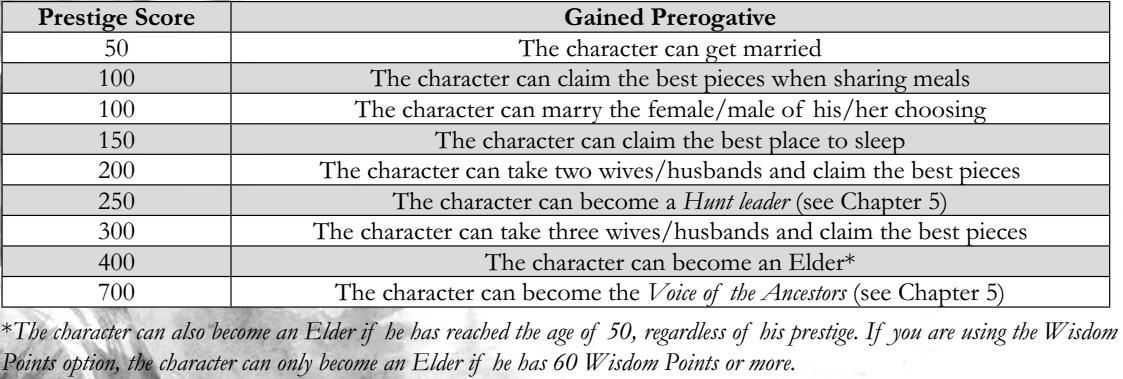
Finally, Prestige is halved when dealing with friendly tribes if the characters can introduce themselves. Hostile tribes or total strangers treat the characters as a prestige of 0. Characters cannot generate prestige between themselves: So making things for party-members don’t generate Generosity, and PvP fights don’t add Bravery.
Equipment
Okay, starting equipment! Everyone starts with summer and winter clothing, weapons of the players choice of average quality, non-magical jewelry, and basic tools to perform your known arts and crafts, start fires, etc. Instead of money, because that doesn’t exist yet, characters start with 1d6+1 Trading Value Points worth of miscellaneous trade goods of the players choice.
There are some restrictions or bonuses as well:
- Mousterian characters can’t start with jewelry, a bone dagger, bone spear, or javelin.
- Long Men can’t start with a set of bolas.
- If you have the Venom of the Viper Strength you start with enough plants to prepare 2d6 cataplasms.
- If you have the Song of the Blackbird or Majesty of the Aurochs Strengths you can start with a flute or drum.
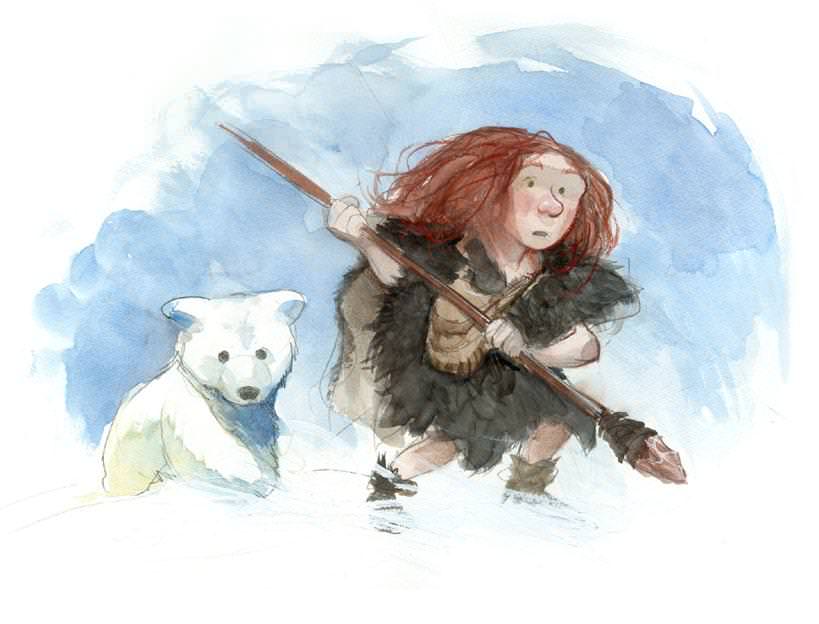
Playing Child Characters
Würm is designed to be all-ages friendly. While there are parts that are not really child appropriate (Pregnancy, cannibalism, etc) the game is simple enough to be played with children, and so there are optional rules so kids can play kid characters! Or for people who want to play out as much of their characters simulated life as possible. Mostly these are just simple modifications to the base rules of character creation. These also act as good “introductory” rules, as they simplify several systems and lead to some character creation “in-game”.
- You choose people, tribe, clan, etc the same as normal.
- When playing a child you start only one Strength, the one based on your People, giving you only a choice between two for faster and simpler creation.
- The Child Weakness is the only weakness child characters start with by default. Child gives y ou a -3 to all Strength tests and Damage (to a minimum of 1), has fewer default Stamina (16 for Long Man, 20 for Bear Man), and a -2 penalty to all Knowledge tests.
- You can take an additional Weakness for an additional Strength or Talent, similar to Adults. Würm actually recommends two different interpretations of this rule: If the character starts the game with the Weakness it represents a congenital, natural, weakness from Birth. With this option the character gets them one additional Strength at the beginning of the game. The other is to give the new Weakness, and one new Strength, during play if the character suffers a trauma, wound, or illness, representing their growth through hardship.
- Instead of all the basic Talents, Children start with only two basic Talents from their culture. This sounds bad, but Child characters should have more time in-game to grow and learn additional Talents compared to characters that start as Adults.
- Equipment is unchanged from Adult characters.
- Child characters start with no Experience, only 2d6 Prestige, and your age must be below 14 if a Long Man or 11 for a Bear Man.
While you start with only one Strength (or two if you take a weakness) you get a second strength at the conclusion of the first Adventure of the campaign.
The third strength is earned when the character has their initiation ceremony. To do this the character must be of age, and have earned at least 3 Experience. Würm recommends playing out the initiation, and a few of the premade adventures are based around characters going through it.
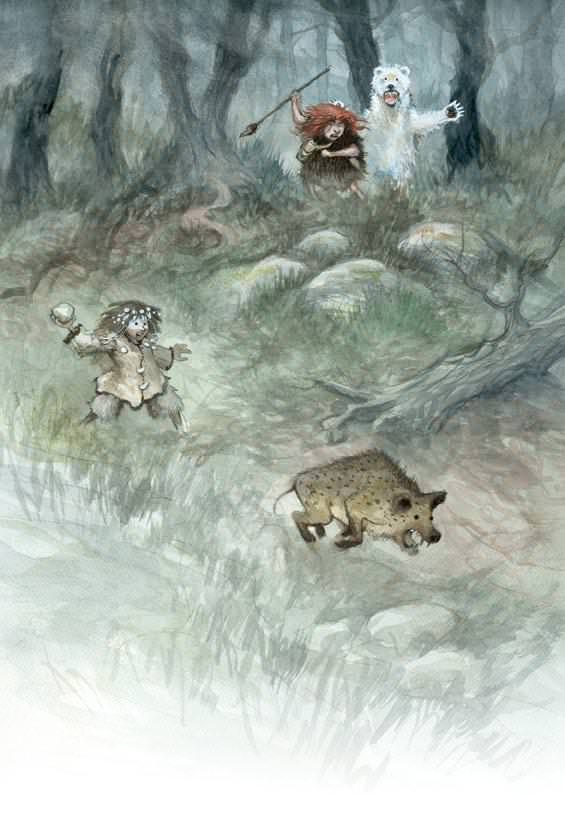
And that wraps up Character Creation! Next time Game System!
Combat and Dangers
Original SA post Chapter 4: Combat and Dangers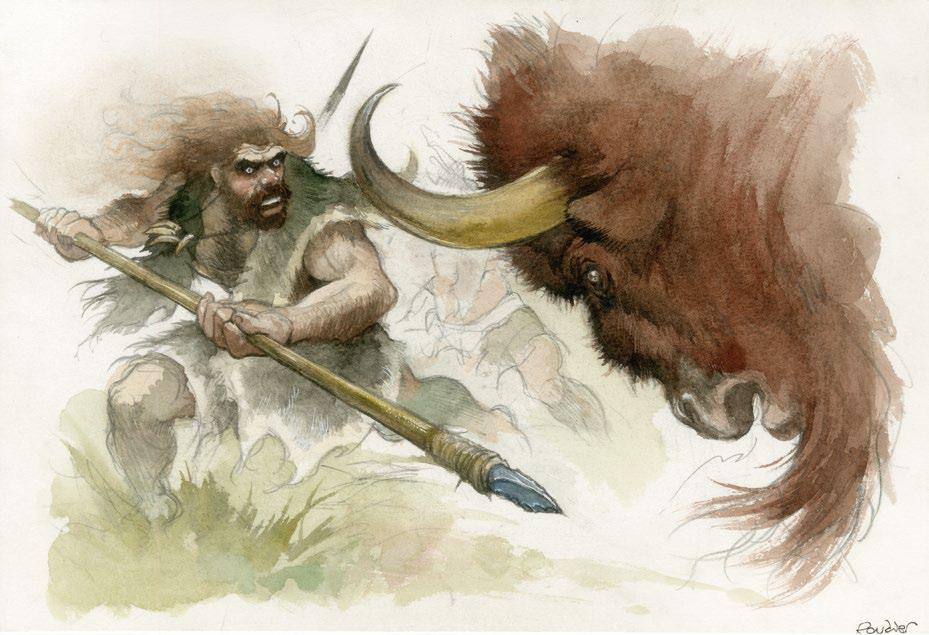
Faudraug Facing the Bison. Character sketch for Vo’huna - Pencil & Watercolour, 2005
This chapter will be way more interesting than the last, because we get into everything involving killing and being killed! Combat in Würm is pretty typical, so I’ll whip through the basics real quick so we can get to the fun stuff.
Initiative, Rounds, Actions, ETC
Initiative is 2d6 for humans, decreasing from highest to lowest. Non-Humans may have different rolls or static bonuses. Each character has two actions they can do on their turn:
- Move a number of meters equal to your Running score (7 for Humans). If you don’t attack in a round, you can move twice.
- Make an attack. Ranged attacks are one throw, while melee attacks can represent a series of blows and attacks. You have to attack either before or after a move, you can’t stop, attack, then run away in the same turn. If you don’t move though, you still just get one attack.
If you decide to do anything in the middle of a fight that’s not one of the above actions you can’t move or fight in that round and get a penalty to dodge any attacks because you’re not paying attention to the fight!
Attacking and Dodging
Attacks are 2d6, if you beat the enemies Dodge score you do damage. Dodge Score for humans by default is 7, with other creatures having varied scores both higher and lower. By default you get one attack per round only. Depending on the result, the game has definite rules for the margin of success:
- Catastrophe: Roll 1d6, on a 2 through 6 you drop your weapon, on a 1 your weapon breaks and you take 1d6 damage as a result.
- Brilliant Success: You do maximum damage for your weapon. Only humans can get a Brilliant Success which is good because some animals can do disgusting amounts of damage.
- Critical Success: Roll damage twice and add the results together.
- Legendary Success: Roll damage four times and add together.
If you do a non-combat action on your turn, you get a -2 to your Dodge for that round because you’re not paying goddamn attention!
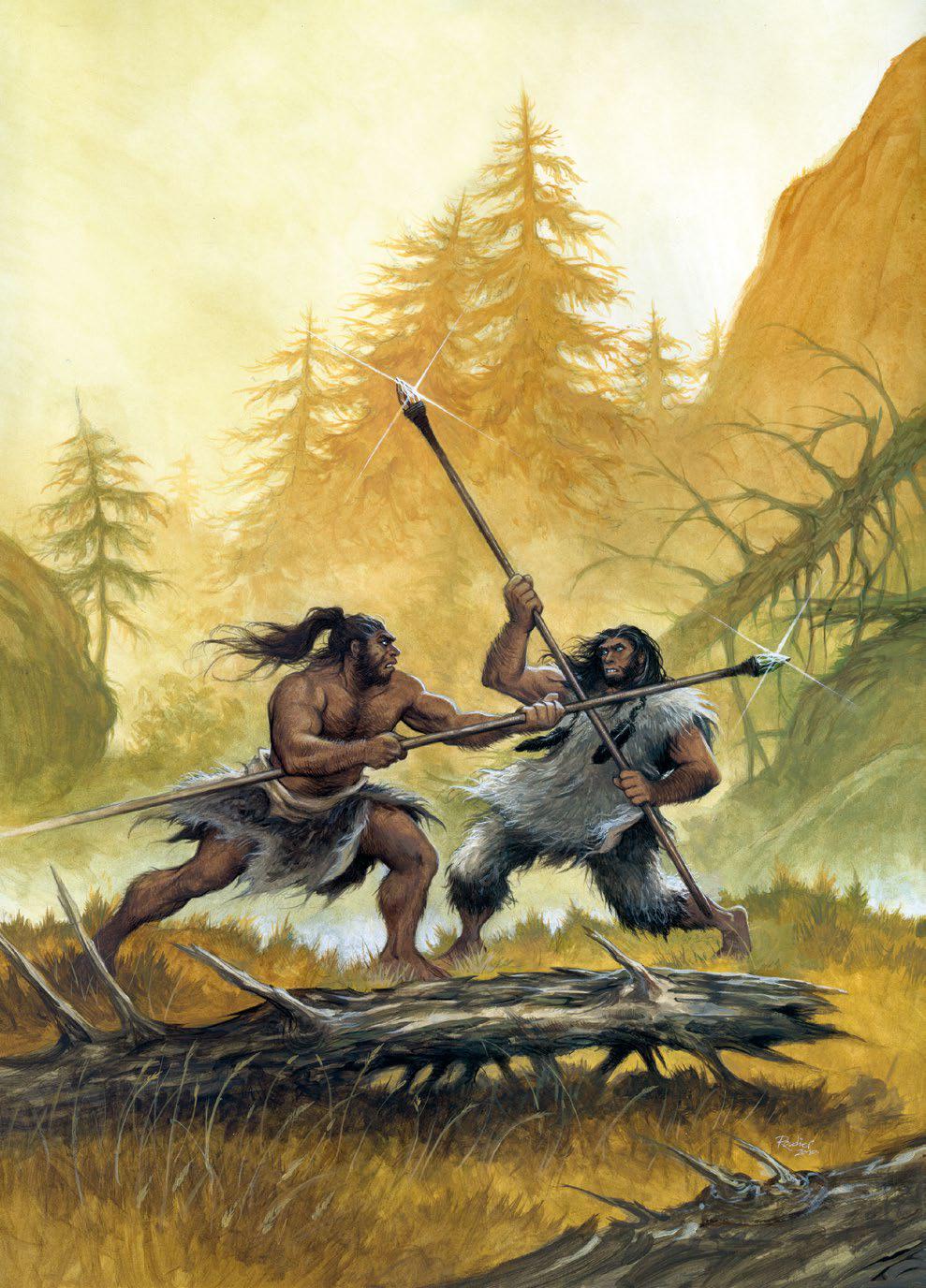
Showdown with the Hunting Crystals. Cover Art for Neanderthal, Vol.3 - Acrylic, 2010
Retreat
If you want to tuck tail and beat feet you have to make a DT 9 Test to bug out. You can choose to use either the dice you would for a Running test or for an Initiative test, players choice. If you succeed you escape the combat and the enemy has to chase you down to continue fighting, fail and you just leave yourself open. Anybody in combat with you gets to immediately make an extra attack against you if they are in hand-to-hand range. Each character can only ever get one extra attack per round, so the first person to fail a Retreat may get wrecked, but later runners in the same round won’t face the extra attacks.

Cautious & Reckless Combat
You can choose to fight Cautiously or Recklessly. If you choose to be Cautious then you get -2 to all Attack Rolls and +2 to your Dodge Score, while Reckless does the opposite. (-2 Dodge, +2 to Attack Rolls).
Charge
If you can move at least 6 meters in a straight line towards an enemy on relatively smooth terrain you can choose to Charge. If you Charge it takes all your actions for the turn. You move up to your maximum movement range, and get a 1d6 bonus to any Damage dealt by the attack. In exchange though you take a -3 to Dodge until your next turn. You can’t combine Charge with Cautious or Reckless Combat.
Total Dodge
Roughly the opposite of Charge. When you choose to Total Dodge you get a 1d6 Bonus to your Dodge Score until your next turn, but can’t perform any attacks. You can move though, but the distance you’re able to move is halved, and can only move after someone has attacked you.
Total Dodge against a Charge
If someone Charges an opponent using Total Dodge, and they miss their attack, the Charging character has to make an Initiative Test of DT 7. If they succeed they stop after the failed attack, if they fail though they must move either 1d6 (For human size or smaller) or 2d6 (for larger than human creatures) meters in a straight line in the direction of the charge. This is mandatory, and is only cut short by physical obstacles.
Attack Roll Modifiers
There’s a bunch of modifiers for Attack Rolls, not going to go over them, have a table:
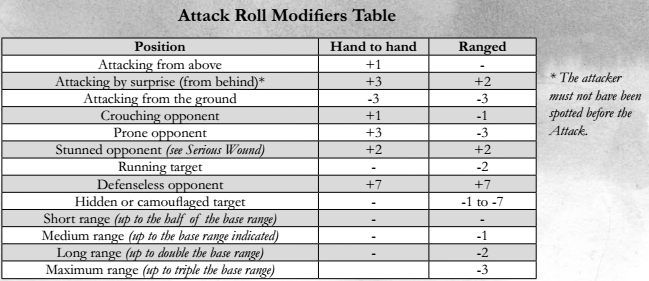
Option: Active Defense
Just optional rules for actively rolling to defend against attacks instead of passive defense. When your character is attacked, the player rolls a Test, if they equal or beat the enemies Attack then they dodge it. Each attack has to be rolled against individually. Bonuses to Dodge Skill translate as flat bonuses to the Dodge Test.
You need a Critical Success on a Dodge to avoid a Critical Attack, and a Critical Dodge automatically avoids any attack thrown at you. If you roll a Catastrophe you fall down and the enemy's Damage is increased by 2. Any subsequent Dodge Tests in the same round are made at -2.
Dual Wielding
You can use two one-handed weapons at a time. You can only attack once, but each round you can choose either a +1 to Attack or Dodge for that round. Characters with the Strength of the Bear or Might of the Bison Strengths can use two-handed weapons in a single hand, with a one-handed weapon as the other, but they get a -3 Penalty to Attack and Damage due to the unwieldiness of the weaponry.
That’s it for the first section covering basic combat rules. I’m trying to make shorter posts for faster updates, so that’s it for the moment!
Next time: Weapons of the Stone Age!
Weapons of the Stone Age
Original SA post Weapons of the Stone AgeWeapons in Würm may seem primitive, but they were good enough to let us survive for longer than most civilizations. Most weapons are made of wood, stone, or bone. Wood is the simplest and easiest to make, stone is used to make harder heavier strikers and sharp cutting edges, while bone weapons made of bone, antler, horn, or ivory is harp and sturdy, and can even be resharpened after use.
Stone or bone weapons are fit into a handle, which is often finely shaped to be straight and sturdy. The bone or stone is attached using glue and strong. The glue is made of birch bark tar, pine tar, beeswax, coal, bones, and fish. This glue is made and stored for later use. The string wraps over the glue fixing the weapon to the handle and is made of tendon, leather, or dried gut.
Weapon Resistance and Breaking Weapons
At the end of every round, if your weapon has caused damage you have to roll 1d6 and check to see what happened to your weapon:
Damaged weapons are usable, but do one less damage until they are repaired by the appropriate Craft. Broken weapons are destroyed and unusable.
Some weapons have special interactions: If you are using a club or axe, and the opponent is using a spear or javelin, you can break their weapon. Get a Critical Success on an attack, and instead of damage you can choose to test its resistance. Normal characters roll 1d3, ones with the Strength of the Bear or Might of the Bison Strengths roll two d3 and keep the highest, Weak characters roll two d3 and keep the lowest. Wait that’s not right… Okay this rule has a minor translation error. Namely, it should be inverted: Strengths should let you keep the lowest not the highest, and Weak should be the opposite. This is because the result of the roll is found on the Weapons Resistance table, where lower results are better. Which honestly is pretty minor. For a game translated by a fairly small company this sort of thing isn’t really unexpected. Otherwise, with that minor correction the rule works fine.
Weapons
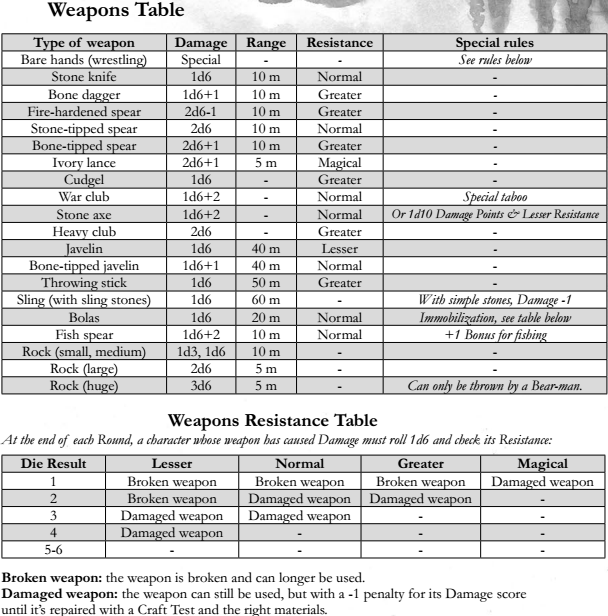
Now, as this section is short on art, I’ll be pulling images of the various weapons from around the internet for illustrative purposes. That said, let’s get to it!
- Stone Knife A stone blade with a wooden handle. More a tool than a weapon, everyone carries at least one as everyday wear. They were used like… knives. Cut plants, hide, meat, carve wood, trim hair, sharpen sticks, and sometimes to stab something. Stone knives are Normal resistance weapons, and do 1d6 Damage.
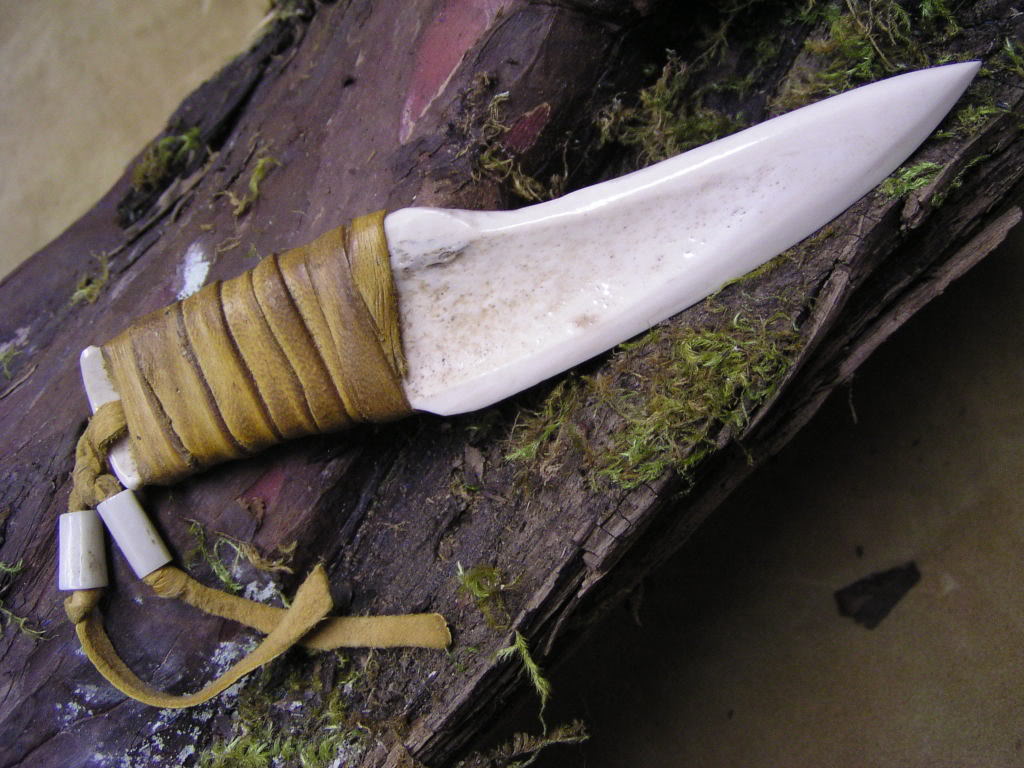
- Bone Dagger A single sharpened piece of bone or ivory, without a separate handle. Bone daggers are sturdier than stone, and have Greater resistance and do 1d6+1 Damage.
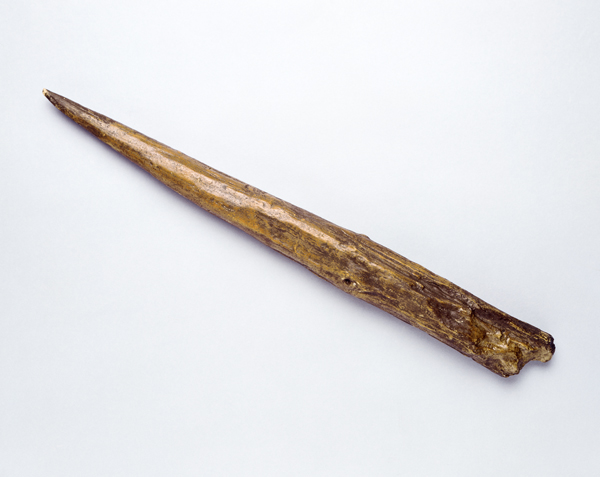
- Fire-Hardened Spear A spear made of polished and fire hardened wood. Not just sharpened sticks, wooden spears are finely balanced and shaped with wicked points. They have Greater resistance, and do 2d6-1 damage.
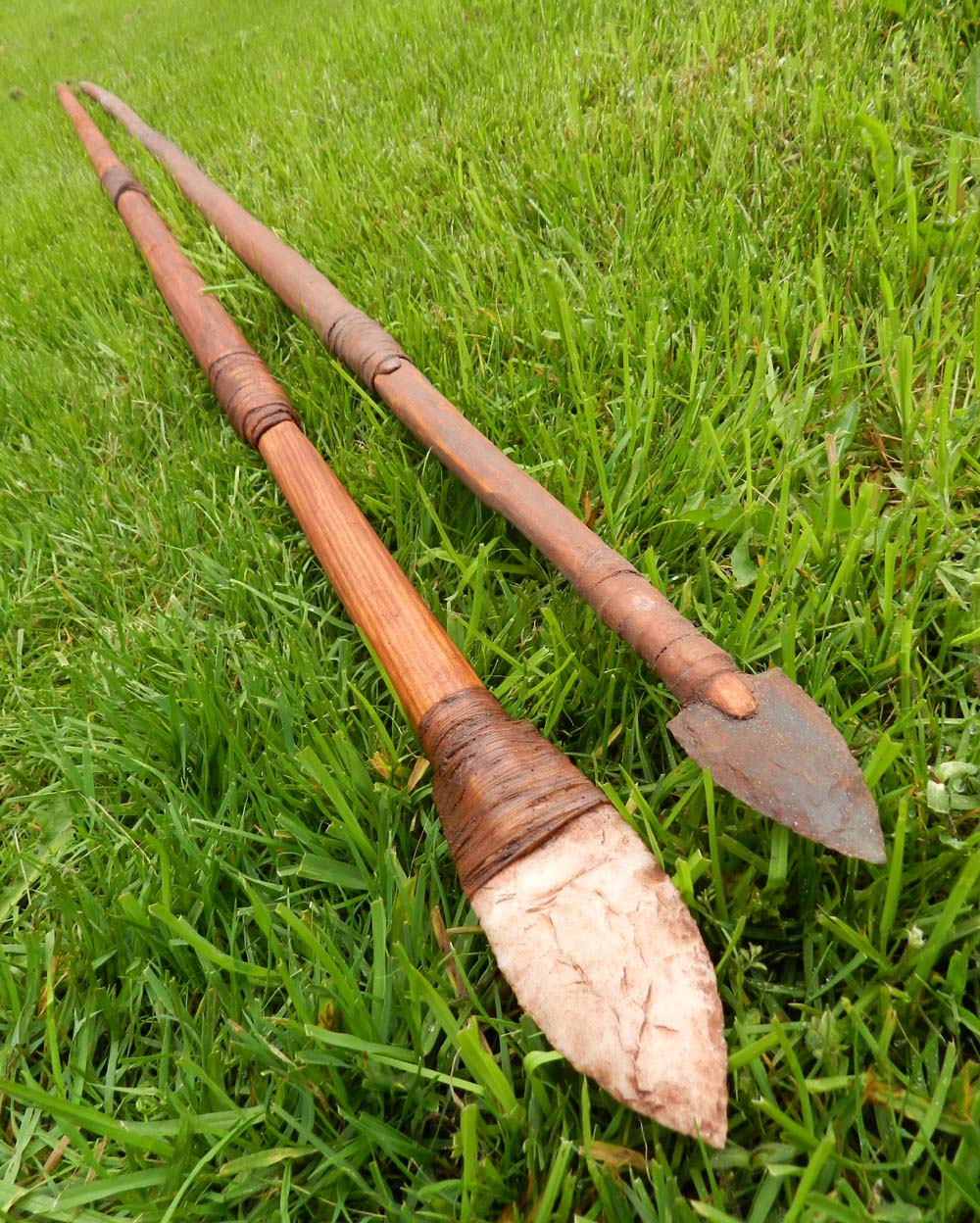
- Stone-Tipped Spear Yep, wooden shaft with a stone tip. Generally the tip is small, to make it harder to break and prevent it getting stuck in bones. It has Normal resistance, stone is more liable to break and chip and is harder to replace than wood, but does a full 2d6 damage.
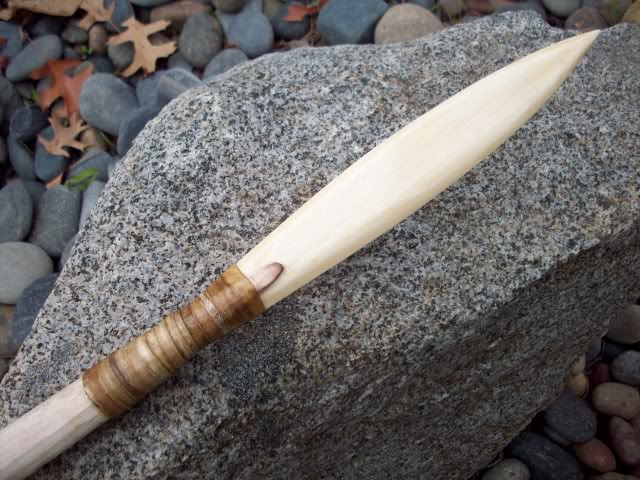
- Bone-Tipped Spear Most often actually tipped with sharpened antler, bone spears are sharper, tougher, and jus better than other types. They are Greater resistance and do 1d6+1 damage.
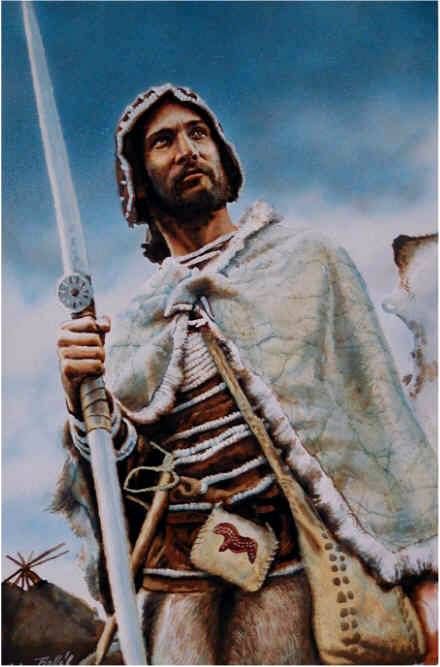
- Ivory Lance A weapon exclusive to the Gravettian culture. It is a long lance made of a single solid piece of shaped mammoth ivory. It is incredibly sturdy, with Magical resistance, and does as much damage as a Bone-Tipped Spear. It’s only weaknesses are it is very heavy, only able to be thrown 5 meters, half the distance of a normal spear.
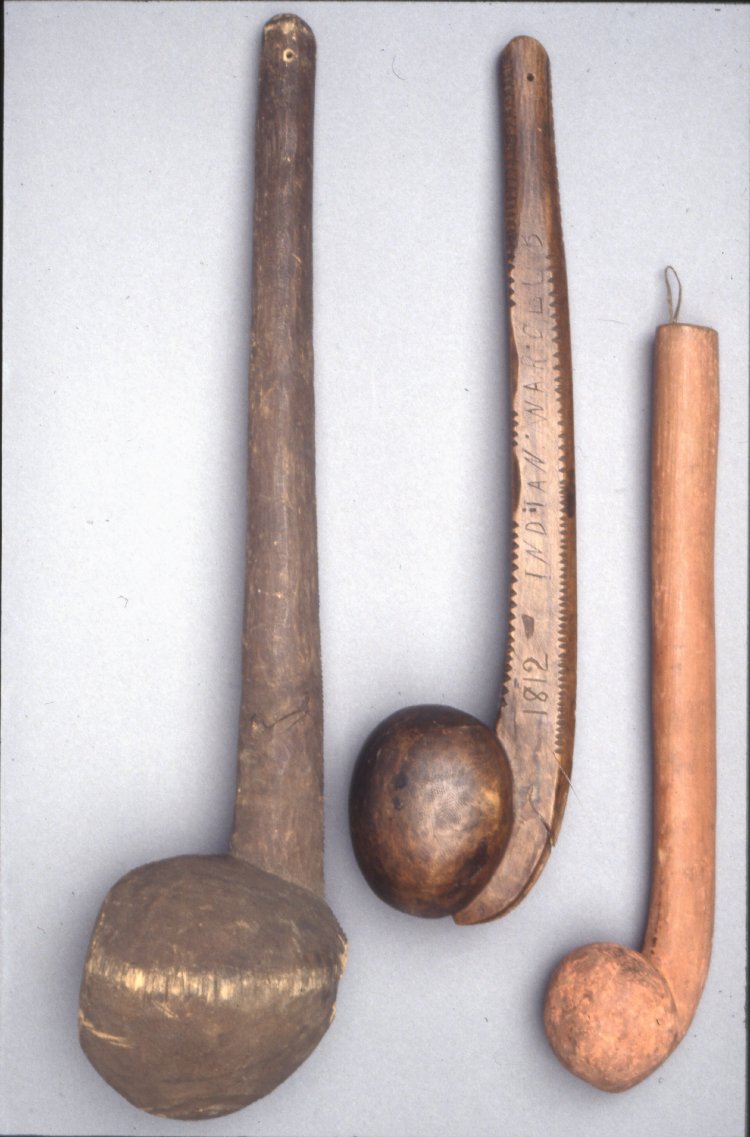
- Cudgel and Heavy Club Essentially the same weapon, but in one and two-handed varieties. These are blunt weapons made of solid hardwood. Once again, these weapons are finely shaped and polished, not just random hunks of lumber picked up off the ground. Both are Greater resistance weapons, doing 1d6 and 2d6 weapons respectively. They cannot be used for ranged attacks.
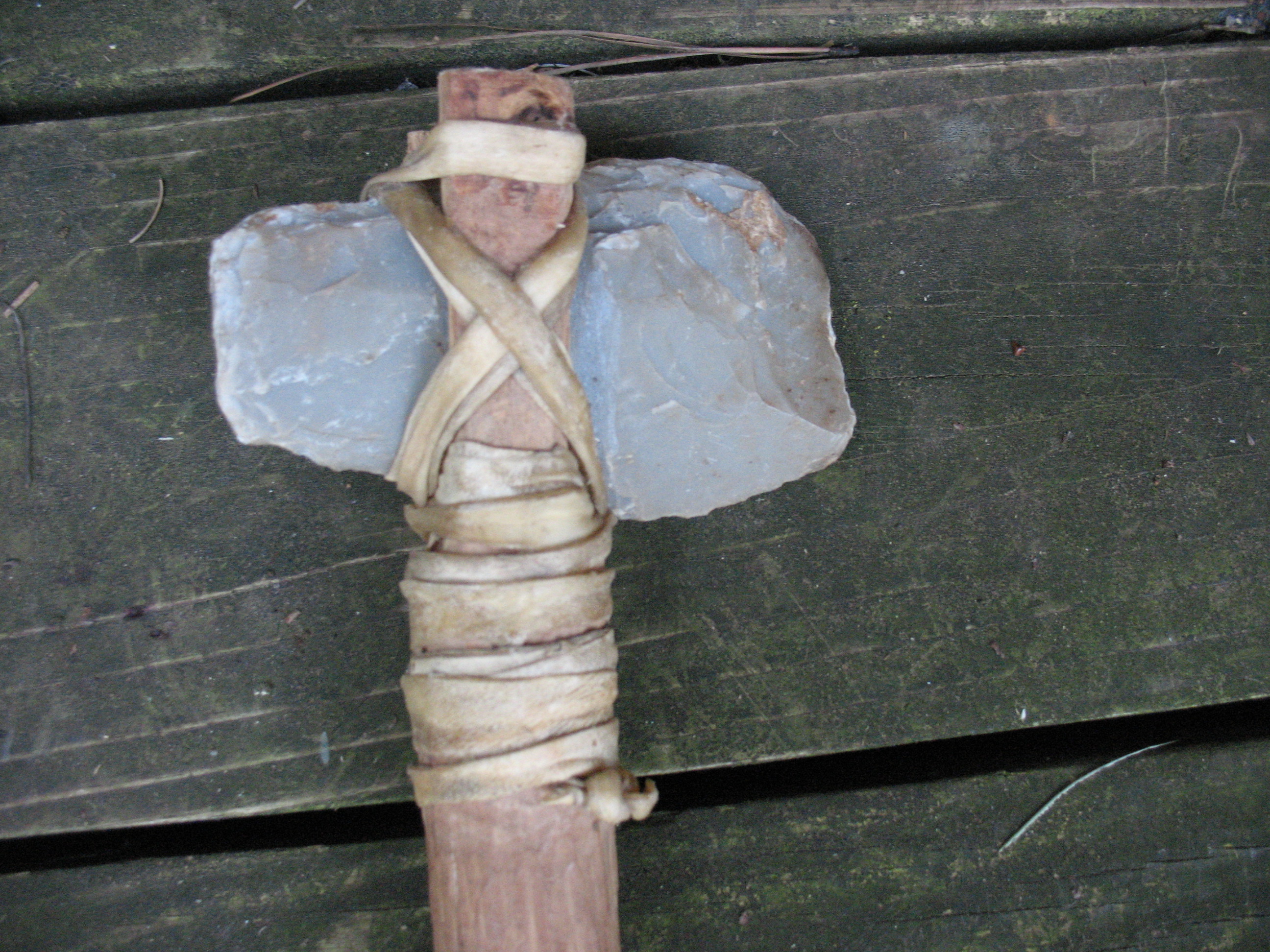
- Stone Axe A weapon-tool made of a large stone flake attached to a short handle. The shaft is often maintained, while the stone head replaced as it chips and wears down. The Stone Axe does 1d6+2 damage, cannot be thrown as an attack, and has Normal resistance. Some stone axes have massive bifaces for heads instead of the normal stone flake. Such a weapon does 1d10 Damage, but has Lesser resistance and cannot be used by Weak characters.
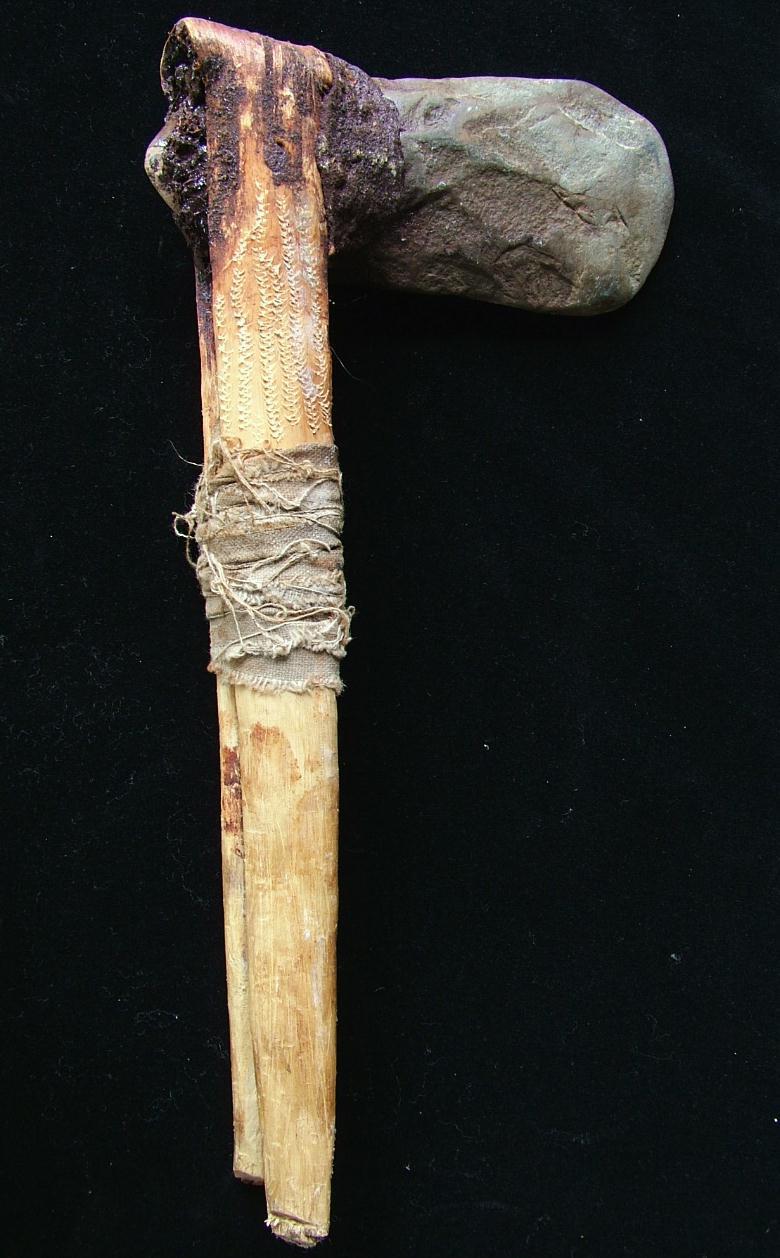
- War Club A blunt weapon made of a wooden shaft with a heavy head of stone, bone, or particularly hard wood. War Clubs are usually one meter long, with a fist-sized head. War clubs are designed to be used in combat with other people, and are semi-sacred. War clubs cannot be touched by non-combatants and never be used against animals, lest you anger the Spirits. War Clubs do 1d6+3 damage and have Normal resistance. They cannot be used as ranged weapons.
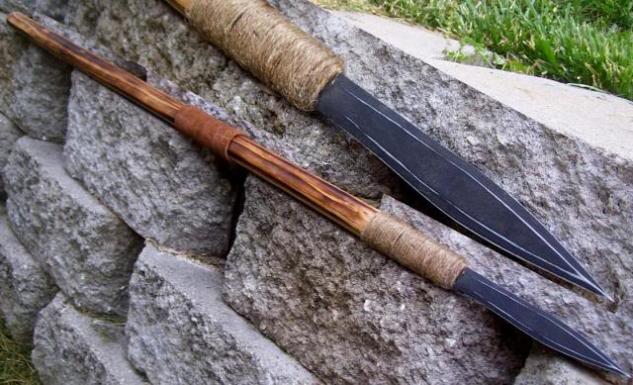
- Javelins Thin wooden lances made for throwing. Spear-throwers and atlatls aren’t in existence yet, but some tribes do fletch their javelins for better accuracy. Some are tipped with bone for extra damage and toughness. Wooden Javelins do 1d6 damage, have a range of 40m and are the only weapon with Lesser resistance. Bone-Tipped Javelins do +1 damage, and have Normal resistance to breaking.
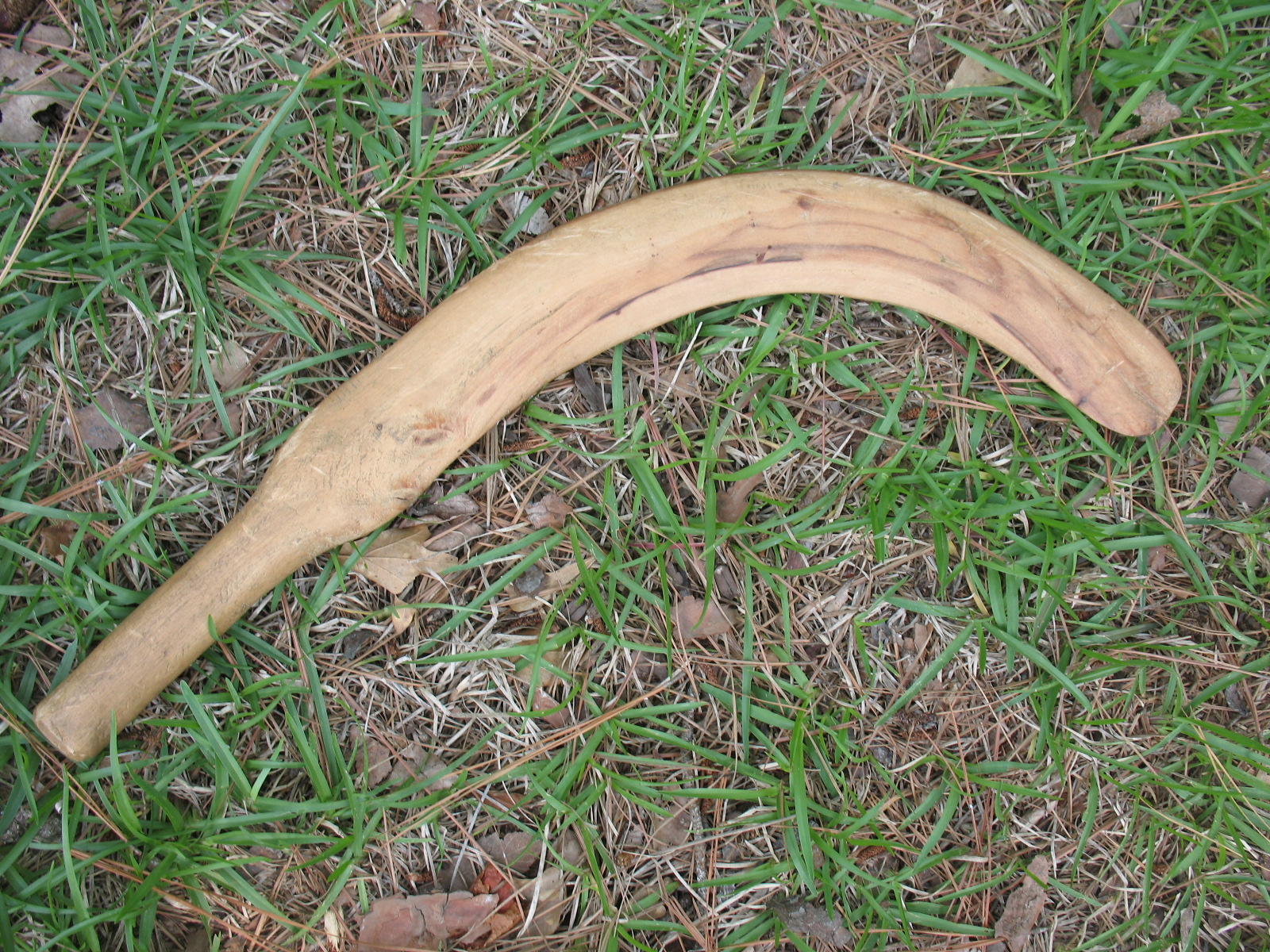
- Throwing Stick A club designed for throwing at enemies, sometimes made of bone but mostly wood. When thrown it rotates through the air parallel to the ground. It is not a boomerang and does not return to the user. Some have holes drilled through them to make a terrifying noise to frighten animals and enemies. Throwing sticks do 1d6 damage, have a range of 50m and Greater resistance.
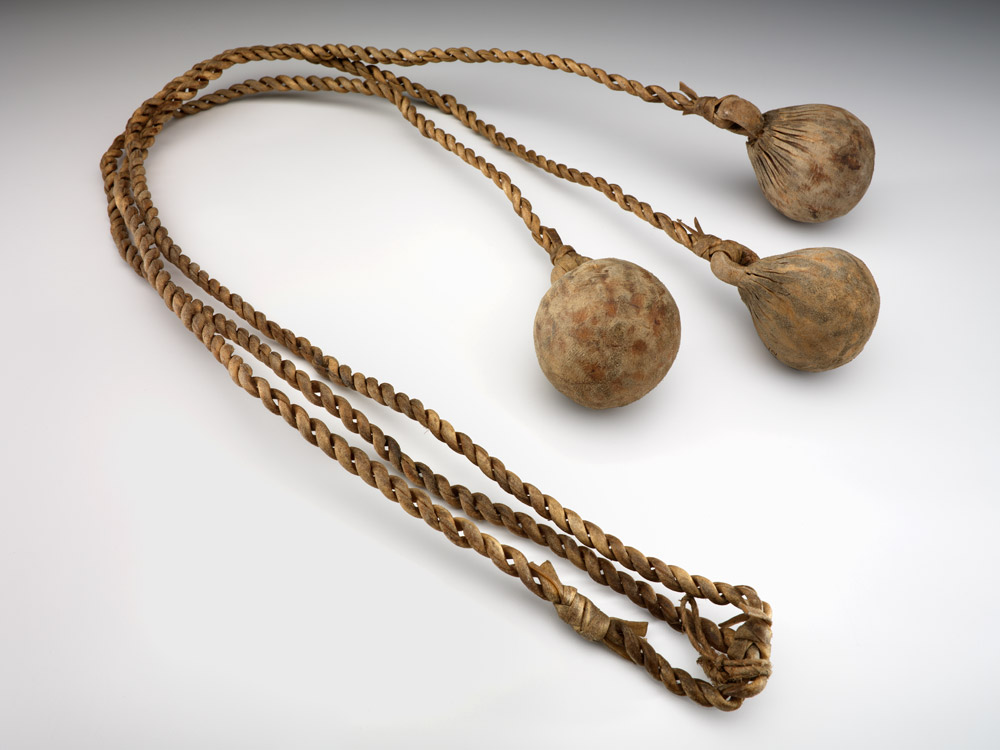
- Bolas Several stone balls, covered in leather and tied together. You throw them at animals to tangle up their legs. Bolas do 1d6 damage on a hit, and have a range of 20m with Normal Resistance. How tangling things work is pretty simple: Get a Brilliant or Critical success. Then you roll 1d6 to determine if they’ve been immobilized. Humans and equivalently sized creatures like horses, deer, and antelopes are immobilized on a result 3 through 6, while larger animals like Aurochs, bison, etc are 4 through 6. Smaller animals aren’t big enough to get tangled up by bolas, and larger animals like mammoths and rhinoceroses are too big. If you hit but miss they just do damage. When the target is incapacitated they take a -3 to Attack rolls, anyone attacking them gets a +3 to Attack, and the incapacitated target does half-damage if they are able to attack at all.
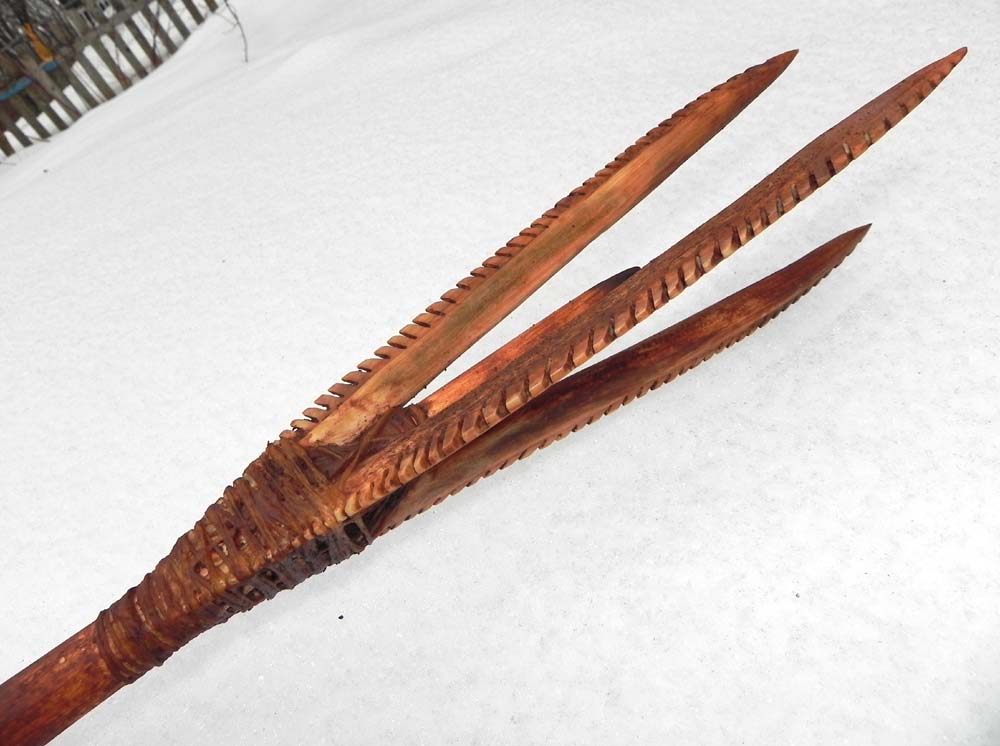
- Fish Spear Only technically a weapon in dire circumstances. A fishing spear is made of wood, with several, sometimes barbed, tips used to spear fish. It does 1d6+2 damage and has Normal resistance. If you go fishing with one, you get a +1 to your Fishing!
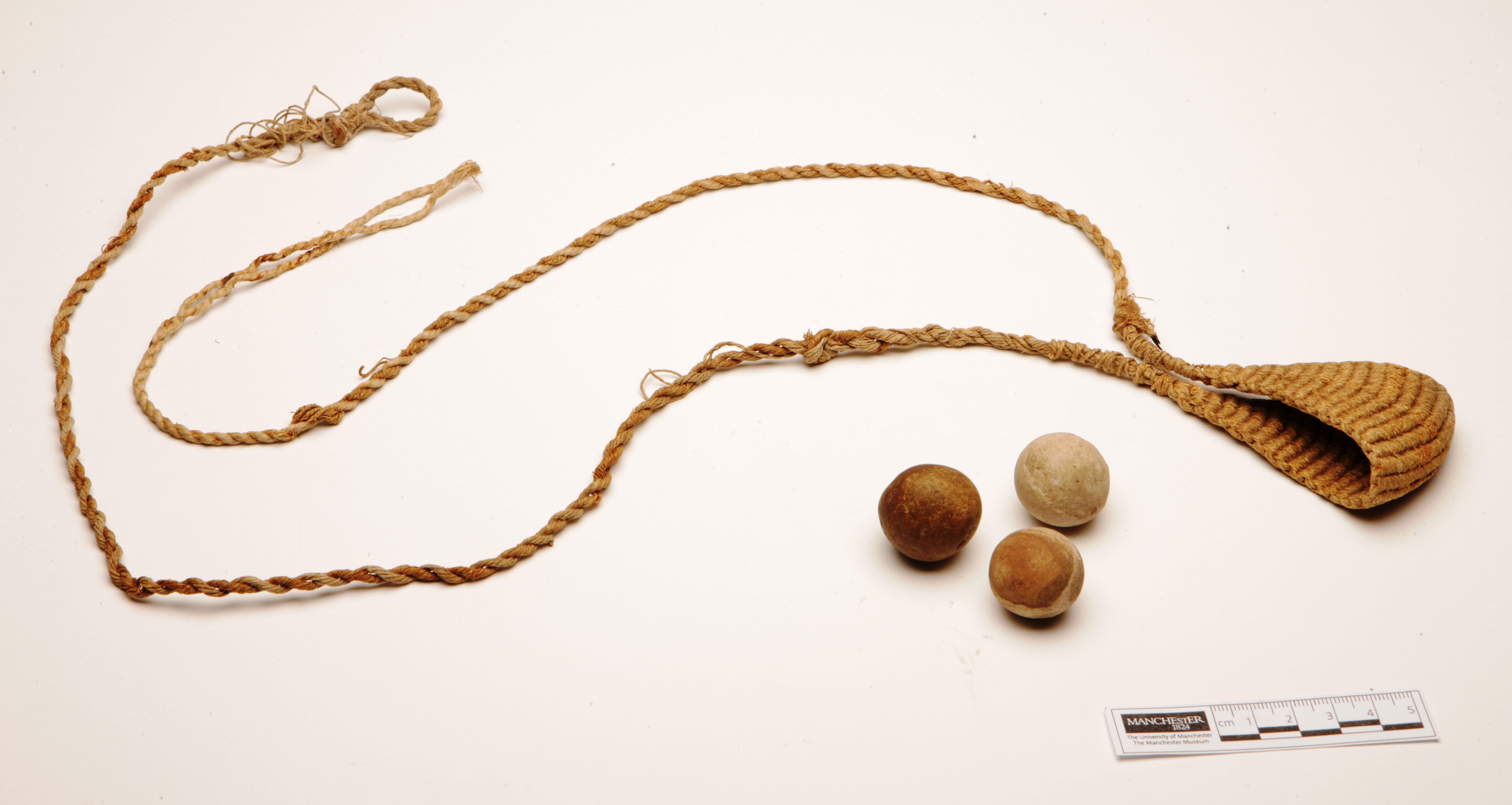
- Sling Made of leather, slings are the dominant ranged weapon in the Paleolithic. They do 1d6 damage, and reach a range of 60m. If you use random rocks off the ground instead of specially chosen or crafted sling stones your Damage takes a -1 Penalty.
- Rocks When all else fails, throw a rock at it. Rocks come in four sizes, small, medium, large, and huge. They do 1d3, 1d6, 2d6, and 3d6 damage respectively. Small and medium rocks have a range of 10m to throw, large and huge 5m. Small rocks can be thrown or wielded one handed by both peoples, but only Bear Men can one-hand use medium rocks, and both people need two hands for large ones! Long Men can’t use huge rocks at all, as only Bear Men with their greater physical strength can use them effectively as weapons.
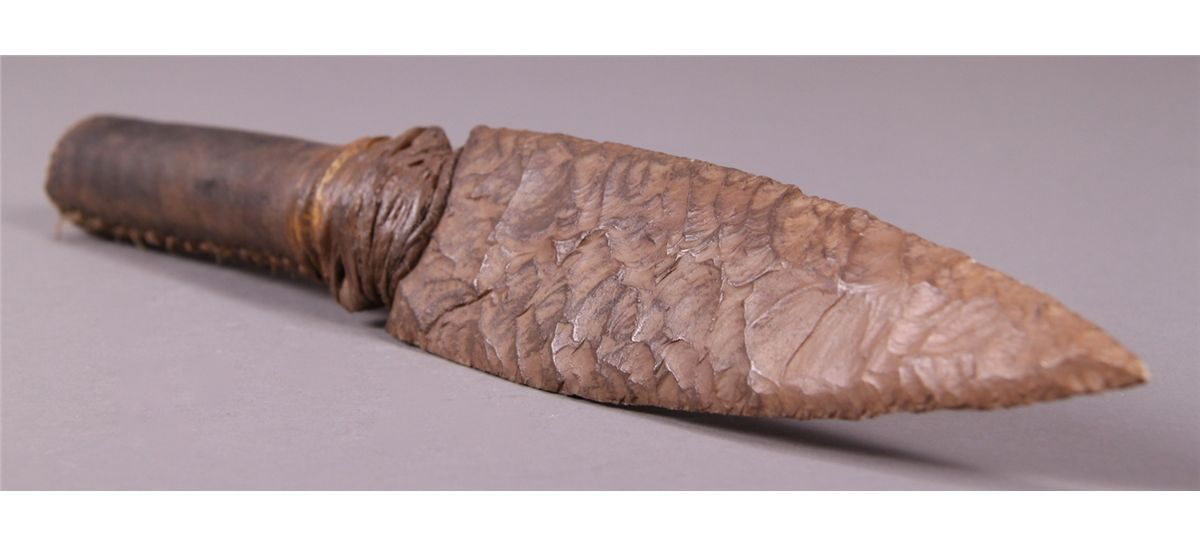
Unarmed Combat
Original SA post
Unarmed Combat
When your weapons break, either in the course of an adventure or in the middle of a fight, you may not have time or opportunity to get them repaired or replaced. If this is the case, you can either pick up a nearby rock, or start whooping ass the oldest of ways: With your fists.
Going mano-a-mano inherently puts you at a disadvantage against an armed enemy. If they have long weapon such as a spear or heavy club then any attacks against them are at -2 for the Attack Test. If you successfully hit them, you get to pick from five Unarmed Combat moves to perform:
- Strike a Blow Punch, kick, headbutt, knee to the groin, etc. You hit their body with your body. You do 1d3 Damage. If you have the Strength of the Bear or Might of the Bison strengths, they only add 1d3 bonus damage, while the Weak Weakness only penalizes 1 from the Damage score.
- Immobilize Wrestle that sucker! You put them in a lock of some sort: You do 1d3 Damage unmodified by any Strengths and unreduced by any Protection gained from armor. In the following rounds, the opponent has to make an opposed Test to break free from the hold. Until they do, they cannot move or take other actions.
- Strangle It works the same as Immobilization, but you do 1d6 Damage unmodified, and get to do the Damage again every following Round as long as the enemy is Strangled. The opponent gets a +2 bonus to break free, but each round after the first attempt to break free he gets a cumulative -1 to the test. (+2, then +1, +0, -1, and so on). If the strangled target is armed with a knife or dagger though, he can instead choose to hit you instead of trying to escape. You can’t defend against this, since you’re kinda grappling them.
- Disarm You try and steal someone else's weapon! A hit means you grab their weapon, and on the opponent’s next turn they have to make an opposed strength test or they lose their weapon. If the attacker’s roll in the strength test is a Critical or Brilliant success, they immediately get their opponent’s weapon. If the opponent wins the test, then your attempt fails and they can then attack you with a +2 bonus to the Attack Test. If you win but don’t get a Brilliant or Critical success, they are disarmed but the weapon is dropped or thrown to the ground and you’ll have to pick it up to use it.
- Lift and Throw You have to both hit them, and then succeed in an opposed strength test. If you succeed, you get to pick them up and hit them with the ground for 1d6 Damage (2d6 with applicable Strengths). Divide the Damage by 3 (round up) to determine how many meters they flew when you chucked them. You can’t throw an opponent much heavier than you are, so larger-than-human targets aren’t getting tossed.
Catastrophes and Critical Blows
The degrees of success for unarmed combat are slightly different from those if you are armed.
- Catastrophe Roll 1d6. On a 2-6 you fuck up so bad you fall over and have to get back up next round, forfeiting your Attack. If you get a 1 you straight faceplant, or twist and ankle, or punch yourself. You take 1d3 damage, no modification.
- Brilliant Success You do maximum damage for that Attack.
- Critical Success You roll the Damage twice and add the results together, plus you get a 1d6 bonus to the next opposed strength test following the attack (such as for grappling, strangling, and throwing).
- Legendary Success Roll Damage four times, add them together, and you get the 1d6 bonus to opposed strength tests applied to the next two tests.
Wrestling with an Animal
Say you want to put a reindeer in a headlock, the difficulty is based on the animal’s weight. The heavier the animal, the more dice it rolls for any opposed strength tests, up to a max weight of 300kg and 4d6. You cannot wrestle an animal weighing more than 300kg, they’re just too dang huge for a human to manhandle. Also, when immobilizing or strangling an animal they can always choose to attack you, but do so at a -3 penalty.
That covers Unarmed, next time Wounds, Damage, and Protection!